#kibi no makibi
Explore tagged Tumblr posts
Text
From Shinoda Myōjin to Sakaki no Mae: the history of Kuzunoha (and a few others)

Abeno by Shūhō Yamakawa (public domain; via wikimedia commons)
A few months ago I asked a more or less representative group of potential readers how familiar they are with Kuzunoha. Save for a single tongue in check response, "that's the Devil Summoner guy with the sideburns, right", the results were fairly uniform: most people are aware that she is a fox and the mother of Abe no Seimei - but not much beyond that.
Kuzunoha is simultaneously probably the single most famous Abe no Seimei-adjacent literary character today, overshadowing even actual historical figures. She arguably changed the Abe no Seimei “canon” in a way few other works did. Even with the “onmyōdō boom” still in full swing in modern popculture, many characters from earlier Seimei tradition remain obscure - but Kuzunoha is arguably equally as famous as her son.
This prominence lead to a variety of misconceptions, most notably to viewing the story according to which Seimei was the son of a fox as considerably older and more integral to his fame than in reality. In particularly disreputable online sources you might even see it being presented as THE fox romance story, an archetype example from the dawn of history of Japanese literature. However, despite stories about foxes and onmyōji both being a mainstay of popular entertainment through the middle ages already, Kuzunoha was only invented in the Edo period - and in the case of most of the major developments pertaining to her we can pinpoint the exact sources.
Read on to find out how the story of Kuzunoha arose and changed through the Edo period, whether the character was always known under this name, what she had to do with Kamo no Yasunori, and more. An excursus will also introduce you to the works and life of Kamo no Yasunori no musume, possibly the most unique thinker of the Heian period. That’s not all you will be able to learn, though.The second half of the article goes beyond Kuzunoha, and introduces a selection of other characters from broadly understood Seimei literature - from Seimei’s wife to an immortal Chinese disciple of the bodhisattva Monju. It was initially intended as a standalone sequel, but I figured it would be preferable to publish both halves in one go. Is listening to gossip a form of divination? How many bones do you need to resurrect a person? What do eclipses have to do with board games? Answers to all these questions - and more - await under the cut!
Before Kuzunoha: introductory notes on foxes in medieval and early modern Japan
Before discussing the development of the story of Kuzunoha, it’s necessary to briefly summarize the history of foxes in Japanese literature. It arguably starts with one of the earliest Japanese chronicles, the Nihon Shoki (720). However, foxes only really appear there as omens. The relevant entries are very brief and essentially boil down to reporting an unusual (for example albinistic) fox was sighted somewhere, or alternatively that a regular fox acted in an unusual way. It’s hard to really call them “stories”. They also don’t really indicate that foxes were regarded as shapeshifters just yet, in contrast with contemporary Chinese sources. The oldest example of a Japanese story involving a fox shapeshifting into a woman - arguably the most famous and widespread subgenre of “fox literature” - appears in the setsuwa collection Nihon Ryōiki (日本霊異記), dated to the early ninth century. This motif, like many other stock elements of fox tales, originates in China. Due to space constraints it is not possible to discuss the development of this genre on the mainland, but it will suffice to say that the literary image of foxes was already fairly solid by the Tang period. A good example of a classic Chinese fox story of a similar sort as the Nihon Ryōiki one is The Tale of Miss Ren from the late eighth century. In both cases, the disguise eventually comes undone, and the true identity of the fox character comes to light, which forces her to leave her human life behind. This remained a mainstay in later periods.
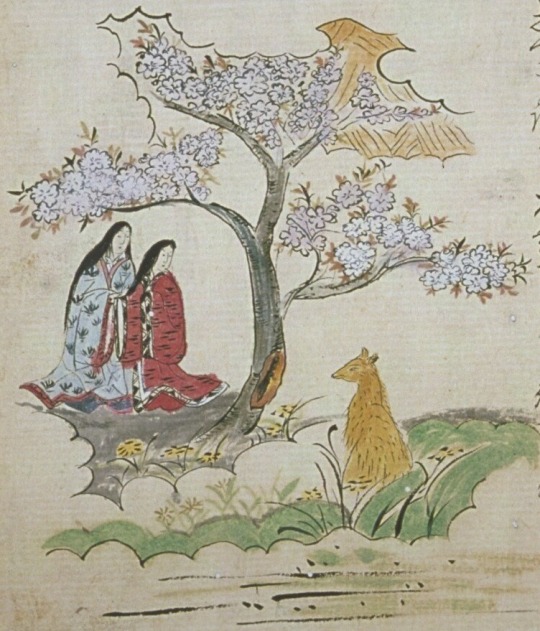
An illustration from Tamamizu Monogatari (Kyoto University Rare Materials Digital Archive; reproduced here for educational purposes only)
The importance of foxes in Japanese literature grew considerably in the “middle ages”, the Kamakura and Muromachi periods. The popularity of stories about animals acting like humans in general increased, in no small part due to the growth of new ideas about the nature of enlightenment. The Tendai school of esoteric Buddhism advanced the view that every living being possessed an innate Buddha nature, and could thus attain enlightenment. A good example of a medieval fox story is Tamamizu Monogatari. It combines elements already present in these discussed earlier, though they are reconfigured in unexpected ways; furthermore, the eponymous fox character’s religious considerations are a fairly major part of the plot. It is worth noting that the story of Tamamo no Mae, Kuzunoha’s main competitor for the title of most famous fox character in the history of Japanese literature, first developed in the middle ages too. However, it is somewhat unconventional in that the original story is just a really weird twist on Sutra of Humane Kings - the fox theming is ultimately somewhat superficial.
The newfound popularity of fox tales never really declined afterwards, and many new ones arose through the Edo period in a variety of mediums, including but not limited to novels, puppet plays and kabuki. The old material was often reinterpreted in new, unexpected ways to suit the evolving taste of the audience. This is the environment in which Kuzunoha arose.
The evolution of Kuzunoha, from Hoki-shō to kabuki
The oldest prototype of Kuzunoha appears in the Hoki-shō (簠簋抄; “The ritual containers, annotated”), an early seventeenth century commentary on one of the most famous medieval religious treatises, Sangoku Sōden Onmyō Kankatsu Hoki Naiden Kin’u Gyokuto Shū (三國相傳陰陽輨轄簠簋内伝金烏玉兎集, “The Book of the Gold Crow and the Jade Rabbit, Secret and Exposed, of the Round Vessel and the Square Vessel, the Wheel and the Wedge, the Yin and the Yang, Transmitted Through the Three Countries” - the title is basically a long enumeration of various dualities representing yin and yang; as you will soon see, various fictional tomes present in stories about Seimei reference it) or Hoki Naiden (簠簋内伝) for short. Its compiler (or compilers) collected multiple, often contradictory, tales about the source of Abe no Seimei’s supposed supernatural powers - many of which were seemingly adaptations of completely unrelated folk tales.
One of them states that Seimei’s mother wasn’t a human, but donned a human guise before giving birth to him. At the age of three Seimei was abandoned by her, but as a parting gift he received a poem explaining that he will be able to meet her in the Shinoda forest in the Izumi province. Many years later, Seimei recalled the poem and decided to travel there to pray at a local shrine. Its deity, known simply as Shinoda Myōjin (信太明神; Myōjin, “bright deity”, is a common historical title of local deities, cf. the likes of Shinra Myōjin or Sekizan Myōjin), appeared to him in the form of an old fox, and told him she is his mother. It’s not Seimei’s only “origin story” collected in this volume, though - elsewhere it states that he was a being from the Dragon Palace (龍宮, Ryūgū). This seemingly didn’t catch on, and we have yet to see a modern work bold enough to make him some sort of fishman.
Hoki-shō does not explain why Seimei’s mother left him, but another likely contemporary collection of short tales, Tsuki no Karumo Shū (“Seaweed gathered in the moonlight”), provides a hint: here Seimei’s mother composes the poem and leaves because his father cheated on her. She is later encountered first by her ex, and then by Seimei, in the Shinoda forest, in both cases taking the form of a fox, much like in the Hoki-shō. She also provides her son with a jewel which lets him understand animals - an item which also appears in other legends about him, though not necessarily in the same context. Curiously, outside of this supernatural episode, this work generally follows historical information about Seimei. It correctly relays that his father was a low ranking court official and that he studied under the famous onmyōji Kamo no Yasunori.
A breakthrough in the history of Kuzunoha occurred with the publication of Ryōi Asai’s Abe no Seimei Monogatari (安倍晴明物語; “The story of Abe no Seimei) in 1662. Various disconnected legends collected in the Hoki-shō and similar sources came to be forged into a single narrative for the first time ever, which turned out to be a successful approach. Seimei, while never really forgotten, became a favorite of Edo period audiences, and a “Seimei boom” of sorts occurred, with numerous new works focused on his life and exploits being published.
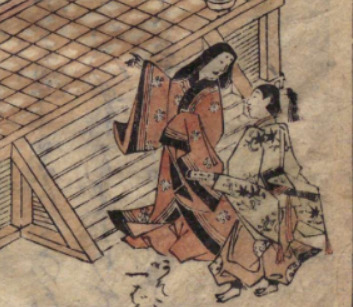
Young Seimei meeting Otohime, as described in Abe no Seimei Monogatari(public domain, via National Archives of Japan Digital Archive; all illustrations from this novel included in this article have been sourced from these scans; another set can be found on the website of the Waseda University Library)
It would be unfair to say that Abe no Seimei Monogatari is just a direct adaptation of Hoki-shō, though. It is an innovative work in many ways, and in some cases rewrites completely unrelated legends with Seimei as the protagonist. For instance, Seimei at one point visits the dragon palace to help Otohime in what is obviously a novel twist on the tale of Urashima Tarō (though it might very well be an echo of his second origin story from the Hoki-shō) - just without any of the repercussions for the protagonist. Seimei was, presumably, built different, to put it colloquially.
Innovations are also present in the section of the story dealing with Seimei’s mother. In contrast with the sources discussed above, Abe no Seimei Monogatari also provides his father with a name - Abe no Yasuna (安倍保名). He is introduced as a farmer living in Abeno, a village near the Shinoda forest (in earlier legends Seimei was said to hail from Nekoshima, located near Hitachi). The reason why the mother leaves is curiously not provided. The novel simply states that one summer day she abandoned her family - and that’s really it for her relevance.
It is not certain if Abe no Seimei Monogatari was a direct influence on the next major work dealing with Seimei's origin, the 1674 puppet play Shinodazuma Tsurigitsune Tsuketari Abe no Seimei Shusshō (しのだづまつりぎつね并あべ晴明出生; “The Shinoda wife, fox trapping and the birth of Abe no Seimei”). While such a connection is not impossible, it might have alternatively depended on a now lost sekkyōbushi (説経節), a type of Buddhist ballad accompanied by shamisen and puppet performances. However, no direct evidence for the story of Kuzunoha ever being adapted in such a form exists.
Regardless of whether there is a connection or not, the play does follow Abe no Seimei Monogatari when it comes to the identity of the eponymous character’s father. It additionally establishes that Yasuna owns the mystic tome Hoki Naiden, here described as a family heirloom passed down since the times of Abe no Nakamaro (more on him later). Most importantly for the topic of this article, many new details regarding the marriage of Seimei’s parents emerge here for the first time.
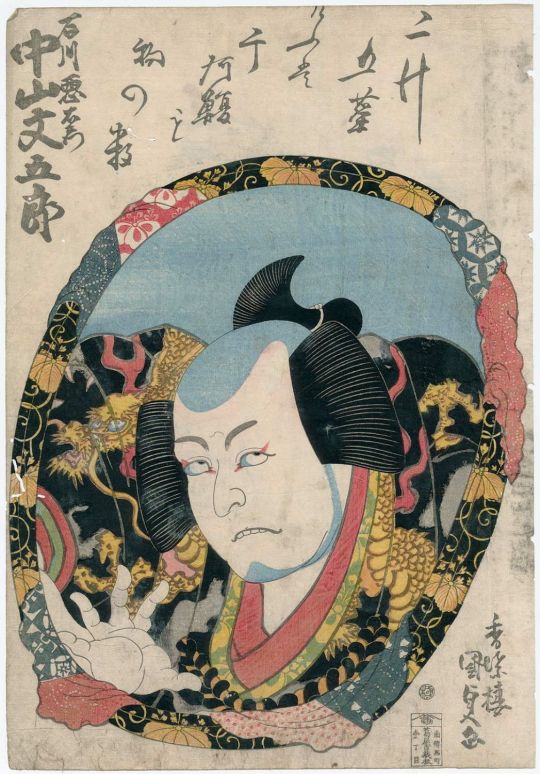
Actor Nakayama Bun'emon as Ishikawa Akuemon (ukiyo-e.org; reproduced here for educational purposes only)
A new character shows up in the relevant part of the story, Ishikawa Akuemon (石川悪右衛門), a brother of Dōman, Seimei’s rival from Abe no Seimei Monogatari and a variety of other sources. While Dōman is most likely based on a historical person (though one with no real relation to Seimei - more on that in a sec), Akuemon is entirely fictional. Through Dōman’s influence he received a government post near the Shinoda forest. His modus operandi is to obtain the liver of a white fox, since his brother told him it can be used to heal his ailing wife. Yasuna encounters him during a hunt, and saves a fox from him. This leads to a fight in which he almost ends up killed, until another fox intervenes. By disguising himself as a priest serving in Akuemon’s family temple he tricks him into sparing Yasuna’s life.
Some time later, Yasuna saves a woman from drowning, and subsequently marries her. He has no choice but to live with her in the Shinoda forest, since through a complex string of events resulting from Akuemon killing his father Abe no Yasuaki (安倍泰明) he had to kill him (and is effectively an outlaw, as I understand). He and the woman eventually have a son.
When the son - who is, obviously, Abe no Seimei - is seven years old, his mother accidentally reveals to him that she is a fox who took human form. She becomes so enchanted by blooming chrysanthemums that she loses grasp of her disguise. Kid Seimei is horrified by this revelation, and his mother decides she has to leave. She leaves a letter for him in which she expresses her sadness about this turn of events, and another for Yasuna, in which she reveals that she was the fox he saved, and that everything that happened between them since was an elaborate way to repay that favor.
It might be worth noting that the idea that foxes were particularly fond of chrysanthemums was a well established trope. It goes back to a poem by Bai Juyi, who in turn influenced a host of classic Japanese poets, including but not limited to Miyako no Yoshika, Ki no Haseo, Shimada no Tadaomi, Ono no Takamura and Sugawara no Michizane. By the Edo period, it was essentially common knowledge, so the scene was less surprising to contemporary audiences than it might be for us.
Despite all of the innovations in Shinodazuma Tsurigitsune Tsuketari Abe no Seimei Shusshō, its author felt no need to provide Yasuna’s wife with a name. That wasn’t exactly unique, though it’s worth stressing once again that the first version of this character from Hoki-shō for all intents and purposes did have a name, Shinoda Myōjin.
The name Kuzunoha appears for the first time in the kabuki play Shinodazuma (信太妻) from 1699. However, its origin lies in Shinodazuma Tsurigitsune Tsuketari Abe no Seimei Shusshō. A poem in the letter Seimei receives from his mother in it ends with the line “the kudzu leaves whose backs are visible” - urami kuzunoha (うらみ葛の葉). This phrase appears fairly common in waka poems. Here it serves as a wordplay - hiragana is utilized because depending on the kanji used, urami can refer not just to the underside of a leaf (裏見) but also to bitterness or resentment (怨み or 恨み). According to Cody M. Poulton, the poem actually originates in a story unrelated to Seimei which circulated in the Izumi province. Its protagonist is a hunter who saves a wounded fox, who then takes the form of a woman and marries him; the similarities are otherwise very vague, as no onmyōdo elements are involved, and the fox commits suicide in the end, after leaving behind the poem.
Naming Kuzunoha was not the only innovation of Shinodazuma. It also makes Akuemon the central villain, eliminating Dōman altogether. His villainy reaches truly cartoony heights - before starting the fox hunt already present in the earlier play he actually tries to pressure a priest at a shrine whose kami uses these animals as messengers to procure a white specimen for him.
Some more focus is given to his wife. In the earlier play, not much is said about her other than that she is sick and Akuemon is convinced he knows how to remedy that. She doesn’t even receive a name. In Shinodazuma she is called Satsuki no Mae. Furthermore, we learn that she secretly hates her husband and is only feigning an illness to avoid him. Her real love is a certain Mitani no Zenji, a retainer of Abe no Yasuna. This character already appears in a very minor role in Shinodazuma Tsurigitsune Tsuketari Abe no Seimei Shusshō, but there he is a retainer of Yasuna’s father, not Yasuna himself.
Zenji’s relevance doesn’t end there. Kuzunoha is actually saved by him, not by Yasuna. However, the conventional romance nonetheless happens, though with a twist. Kuzunoha must reveal her true form because Yasuna has an evil younger brother, Dakaku no Suke, who shows up near the end to try to force Kuzunoha to have sex with him. To achieve that he threatens that he will kill kid Seimei. In response, his mother reveals that she is a fox, and flees. Kuzunoha returns one last time in the final scene of the play after Seimei manages to find her in the Shinoda forest with the help of another new character, a cook named Kisuke. This role was apparently added entirely to accommodate the comedic actor Yamatoya Jinbei II (大和���甚兵衛).
Elements of Shinodazuma and its earlier partial namesake were both incorporated into yet another play, Shinoda no Mori Onna Urakata (“Female Diviner in the Shinoda Forest”), which in turn influenced the single most famous portrayal of Kuzunoha, commonly referred to simply as, nomen omen, Kuzunoha. It dates to 1734, and was originally the fourth act of a five act play, Ashiya Dōman Ōuchi Kagami (芦屋道満大内鑑; “A Courtly Mirror of Ashiya Dōman”) by Izumo Takeda (竹田出雲) II. However, the full version is rarely performed today. As you can probably guess from the title, Ashiya Dōman Ōuchi Kagami puts Dōman, here also referred to as Ashiya no Hyōe Michitaru (芦屋兵衛道満), back into the spotlight, reversing the trend of making Akuemon more prominent. The plot is essentially a succession struggle between him and Abe no Yasuna, with a variety of unexpected twists. Both of them are portrayed as students of Kamo no Yasunori (here written as 加茂保憲 instead of the expected 賀茂保憲), who passes away prematurely without designating an heir from among his disciples. This is quite troublesome, not least because the legitimate heir will gain control over the mystical tome Kin’u Gyokuto Shū (金鳥玉兎集), which originally belonged to a Chinese sage named Hakudō (this is not the last time you’ll see him in this article) before being passed down to Yasunori. Various factions in the court aim to secure control over it to effectively control the country with the mystical divinatory knowledge contained within.
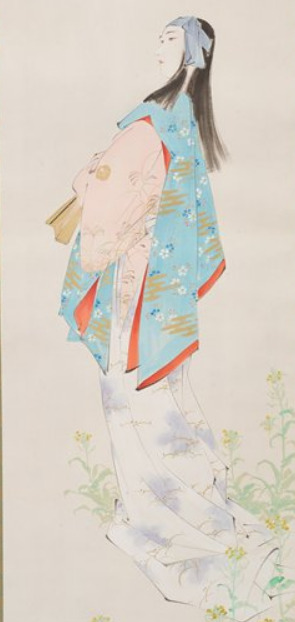
Sakaki no Mae (Minneapolis Institute of Art; reproduced here for educational purposes only)
While most characters are unaware of this, Yasunori intended to have his adopted daughter Sakaki no Mae (榊の前) marry Yasuna, and to give him Kin’u Gyokuto Shū. However, as he failed to do so in time, and only provided his daughter with a key to the secret spot where the book is hidden, a plot is set in motion by his wife. She hides the book and accuses Sakaki no Mae of stealing it to give it to Yasuna against her father’s wishes. Sakaki, who is innocent and in fact refused to open the hiding spot of the book (not that it accomplished much since her stepmother illicitly prepared a copy of the key), decides to put the blame entirely on herself to protect Yasuna and then commits suicide. However, when Yasuna learns about that he is overcome by grief and disappears.
Meanwhile, the widow’s brother Jibu no Tayū (治部大輔), who is also her co-conspirator, meets with his son-in-law Michitaru to give him the stolen Kin’u Gyokuto Shū. He orders him to use the book to divine how to make sure Miyasudokoro (御息所; not the Tale of Genji character), one of crown prince Sakuragi’s (桜木親王) concubines, who belongs to the same courtly faction, will be the first to conceive an heir. Michitaru states that the best way will be the dakini no hō (荼枳尼の法) a secret ritual which requires the liver of a white fox. Jibu no Tayū’s minion Akuemon, who as far as I can tell is not a relative of Michitaru/Dōman here, is tasked with procuring it, since he comes from an area where white foxes can be easily found.
It should be noted here that Michitaru is himself not necessarily portrayed as malevolent in this scene. While he is a participant in this scheme, and even performs rituals meant to help Akuemon with killing Rokunokimi (六の君; also not the Tale of Genji character), the concubine favored by Jibu no Tayū’s rivals, he only acts under the threat of losing both Kin’u Gyokuto Shū and his wife Tsukubane (築羽根).
All of the soap opera-worthy courtly drama forms the first act of the play. Kuzunoha only appears in the second. As we learn, she is the younger sister of Sakaki no Mae, and looks exactly the same as her. Yasuna encounters her when he reaches the Shinoda forest. Due to lacking clarity of mind, he at first assumes that he got reunited with Sakaki no Mae. However, Kuzunoha manages to help him overcome his grief, and explains she is not who she assumes she is. Yasuna is nonetheless still smitten, and asks her parents (it would appear Kuzunoha was not adopted by Kamo no Yasunori unlike her sister), Shinoda no Shōji (信太庄司) and his wife Shigarami (柵), to let them get married.
Alas, it turns out this is impossible, because Kuzunoha’s parents already promised her to her cousin… Akuemon. Following the universal principle of “speak of the devil and he doth appear”, Akuemon promptly appears, chasing a white fox to complete the mission he was entrusted with earlier. He is instantly thwarted by Yasuna and his attendant Yokanbei (与勘平). The latter then leads Kuzunoha and her parents to safety, but Yasuna apparently doesn’t notice this, and for a moment he fears that she was kidnapped. However, his worries soon disappear, as she appears again out of nowhere. In the culmination of the second act, the two then decide to hide for some time in a remote village, Abeno (the same one as in Abe no Seimei Monogatari).
What follows sounds almost like a comedy of errors. Long story short, it turns out that Michitaru has in fact saved Rokunokimi from Akuemon and hid her in his house. When Jibu no Tayū learns about this, he orders her to be killed (again), which triggers a chain reaction. Michitaru by accident kills his father, who had no part in the plot, but tried to take the blame to shield his son from Jibu no Tayū’s wrath. Michitaru’s wife then kills her father, as she has learned about his nefarious intentions and about pressuring Michitaru into helping him. In the aftermath of all of that, Michitaru realizes he has had enough and should go back to honest onmyōdo practice he was supposed to engage in as a student of Kamo no Yasunori full time. He takes the new name Dōman to signify his transformation.
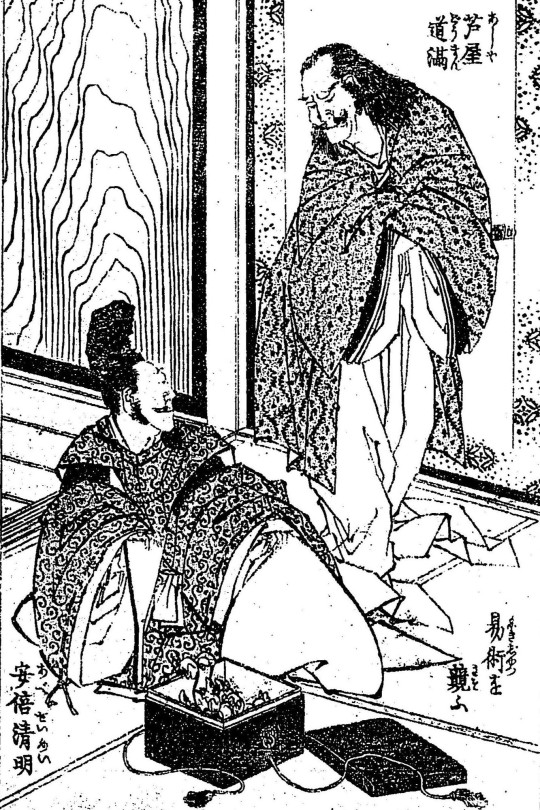
Seimei and Dōman, as depicted by Hokusai (wikimedia commons)
As I already pointed out earlier, the play doesn’t follow Dōman’s usual characterization. Quite the opposite, it’s pretty much a conscious reversal - that’s where the “mirror” in the title actually comes from. Other fictional portrayals of Dōman make him a villainous counterpart of Seimei, and Edo period audiences were well aware of that. There was no shortage of works focused on their rivalry. It’s explored in detail in Abe no Seimei Monogatari, but also for example in the 1792 novel Abe no Seimei Ichidaiki (安倍晴明一代記, “Abe no Seimei’s Life Story”).
It’s worth noting that Dōman’s villainy might have a vague historical basis. It generally assumed that he was inspired by a certain, nomen omen, Dōman (道満), known from the Seiji Yōryaku (政事要略). He was reportedly employed by Takashina no Mitsuko (高階光子) in 1008. He is described as a hōshi onmyōji (法師陰陽師), literally “ priest onmyōji” - a designation for an unofficial onmyōji, basically. Such individuals were seemingly particularly commonly hired by courtiers to curse their rivals (something a regular onmyōji was legally prohibited from engaging with). A reference to a hōshi onmyōji being accused of that is preserved in Fujiwara no Sanesuki’s diary, the Shōyūki (小右記), for example. It is not entirely uncertain if the historical Dōman was involved in similar activities, it is clear that his fictional derivative is based on the curse specialists.
The connection between history and fiction should not be overestimated, though. The kinship between the historical and fictional Dōmans is ultimately quite vague, and the former didn’t really have anything to do with Seimei; their rivalry is an entirely fictitious invention. In particularly it’s worth pointing out it’s basically the standard to portray Dōman as older than Seimei, while the only references to his historical counterpart postdate Seimei’s death by three years - and considering he was unusually long-lived, it’s easier to assume they had nothing to do with each other than that Dōman was somehow even older than him.
Putting the historical Dōman aside, the third act was essentially custom tailored towards the tastes of contemporary audiences, but surprisingly failed to leave a lasting impact. It is instead the fourth act which became the most famous part of the play, and the most famous portrayal of Kuzunoha. It starts with a timeskip: as we learn, Yasuna and Kuzunoha got married and had a son, who is now five years old. However, it turns out that his mother is in fact not the real Kuzunoha. This is revealed when she appears with her parents to visit Yasuna - she’s been bedridden for years in the aftermath of the escape, and only recovered recently. Her parents decided to let her and Yasuna get married. However, they don’t find him at home, since he left to journey to a number of religious sites to pray for his family. They only encounter his wife. As you can probably guess, it turns out that the “Kuzunoha” Yasuna spent the past half a decade with is in fact the fox he saved from Akuemon. When this comes to light, she bids farewell to her son, and tells him to treat the real Kuzunoha as his mother instead from now on.
When Yasuna returns, and learns what happened from the real Kuzunoha, he decides that they need to find the fox Kuzunoha. His son and the real Kuzunoha decide to assist him. Like in every other version involving a search, they eventually manage to find the fox Kuzunoha in the Shinoda forest. She shows herself to them in her true form, that of a century old white fox, and reveals that while she has cast away her earthly attachments, she plans to nonetheless still protect her son. However, to that end she had to cast away her human disguise anyway, as a fox who falls in love with a human will eventually lose all supernatural abilities otherwise. This idea is an invention of the author (had this been an established motif earlier, Tamamizu Monogatari’s namesake protagonist would have no inner dilemmas to struggle with, arguably).
After this matter is settled, the protagonists encounter Dōman. Since they are not aware of his recent deeds, they initially assume that his visit is part of some new scheme. They also accuse him of engineering the theft of Kin’u Gyokuto Shū. However, he explains that he was a tool in an evil plot before, but had a change of heart. He admits the theft accusation is not unfounded, but also that he is not responsible for Sakaki no Mae’s suicide. To atone for his past deeds, he gives the book to Yasuna. However, he says that he is too old to use it, and Dōman should instead pass it on to his son (this is probably another intentional subversion - as you’ll see later, in another story Dōman crafts an elaborate scheme to steal this book from Seimei). When the kid receives the book, he is instantly able to interpret its title. He explains that it refers to a rabbit who lives on the moon and a crow who lives in the sun, and that the book contains knowledge necessary to understand everything on earth and in heaven. Dōman praises Yasuna for teaching his son well, but he clarifies that the boy must have inherited the talent of his biological mother, who was a white fox.
Dōman is aware of a case of a supernaturally gifted kid born to a human-fox couple in China (I’m not sure if this references a specific story, also note this is not an universal motif - in at least one Tang period tale children from a similar relationship die prematurely), and therefore to verify Yasuna's claim decides to test his son’s skills. The boy effortlessly answers all of his questions. Dōman is so impressed he bestows the name Seimei upon him - he was simply referred to as Dōji (童子, “boy” - not exactly a creative name) before. To celebrate, Yasuna and Dōman decide to visit the Shinoda shrine, leaving Kuzunoha and Seimei behind.

Nakamura Utaemon III as Yakanbei, Sawamura Kunitarō II as Kuzunoha, and Arashi Rikan II as Yokanbei (Museum of Fine Arts Boston; reproduced here for educational purposes only)
Since things are evidently going too well, Akuemon suddenly appears once again, accompanied by a group of thugs. He confronts the protagonists and tries to kidnap the real Kuzunoha, but his plan is foiled by the intervention of Yokanbei and an associate of fox Kuzunoha, another white fox, who turns into a copy of him. He calls himself Yakanbei (野干平) - a pun on Yokanbei’s name and the term yakan (射干; from Chinese yegan), which could refer either to a fox-like legendary animal, a jackal, or simply a fox. The scene is intentionally comedic, and it actually takes Yokanbei a while to realize there’s a copy of him running around. In some stage adaptations the sequence was extended further with the appearance of a female servant who is yet another fox in disguise.
After the successful rescue yet another timeskip happens. The final act shows Seimei at the age of eight. His parents decide to finally take him to Kyoto. He is already renowned for his skill, and the crown prince mentioned in passing earlier wants to meet him. However, after arriving in the capital Yasuna temporarily leaves his family, and through an unlucky twist of fate ends up killed by Akuemon, who is busy with a new scheme to curse Rokunokimi. Thankfully, when he later arrives in the court, carrying a crate which contains both a doll meant to be utilized to that end and Yasuna’s corpse, the plot is revealed through a joint effort of Seimei and Dōman. Seimei then resurrects his father, while Akuemon is executed… and that’s where the story ends (with no foxes in sight).
In the end, it might appear at first glance the play regarded as the most famous take on Kuzunoha doesn’t contain all that much Kuzunoha - not the fox Kuzunoha, at least. It’s really a play about Dōman and Yasuna in the end. Kuzunoha actually comes across as sort of expandable and forgettable in dry summaries of the play, and I don’t think mine really gives a different impression. To be fair, it’s actually a genuine theory that the apparent disposability of female characters in this case served as a criticism of the low position of women in Tokugawa society.
Regardless of whether this is true or not, it was ultimately Kuzunoha, and not Dōman, who made the play famous - and that’s why, as I briefly mentioned earlier, it’s uncommon to see the whole play on stage. It’s typically reduced just to act IV - which does actually revolve around Kuzunoha (or, to be more precise, Kuzunohas). There are two reasons behind that.
For starters, the scene of a mother parting with her child emotionally resonated with Edo period audiences to a greater degree than anything else Ashiya Dōman Ōuchi Kagami had to offer. Sure, it might be short, especially compared to the lengthy sections dealing with multi-layered courtly intrigues - but it had something they lacked: it was relatable. Making sure plays resonate with audiences, which consisted largely of commoners - often commoners who represented relatively historically recent social strata molded by changes in economy in the Edo period at that - was a common concern of playwrights. While many dealt with the distant past - especially the Heian period and the tumultuous transition into the middle ages - conscious effort was often made to incorporate contemporary elements, or to emphasize down to earth concerns, precisely to that end. The results weren’t always successful, and in some cases end up heavenly-handed and unintentionally comedic, but Takeda Izumo II evidently pulled it off. It worked so well that the rest of the play became basically unnecessary.
Furthermore, whether adapted in the form of a puppet play (as originally intended) or kabuki, the role of Kuzunoha was considered suitable for showcasing the skills of performers. Special effects, and in particular transformations from one character into another, were incredibly popular - that’s why so many plays from the Edo period have plots involving shapeshifters, doubles, mistaken identity or a combination of some or all of those elements. Foxes naturally provide a great venue for that - and Kuzunoha isn’t even the only time Takeda Izumo II capitalized on it (you will likely get to see another famous example on this blog in a few months).
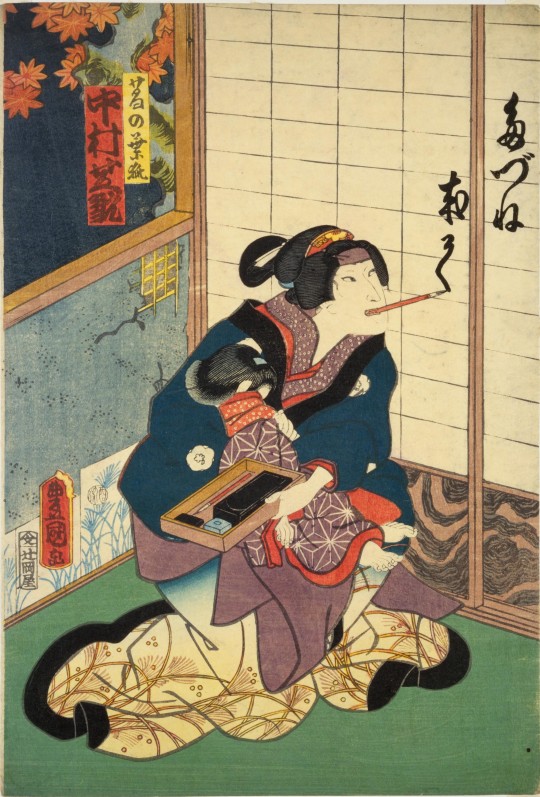
Kuzunoha writing her parting poem with a brush held in her teeth (wikimedia commons)
When it comes to puppet plays, the greatest accomplishment of Kuzunoha was arguably facilitating the invention of a complex type of puppet requiring three people to operate, utilized for the first time in the scene involving her, Yokanbei and Yakanbei. In kabuki adaptations, Kuzunoha’s shapeshifting between human and fox forms is reflected by rapid change of costumes - basically the default way to measure an actor’s skill. Sometimes this is boosted further by speech quirks also used for other fox characters in kabuki. Furthermore, the actor playing her is often expected to write the poem she leaves before abandoning her family holding a brush in his (it’s an onnagata role, ie. a female character played by a man) teeth, cradling a prop representing infant not-yet-Seimei in both hands. A Meiji innovation making the role even more challenging was to have one actor play both Kuzunohas - which, naturally, required even faster costume changes. In some cases, a hat with a fox mask hidden in it is used to make it particularly rapid. Through this combination of factors, Kuzunoha, initially a minor addition to a corpus of legends about a popular protagonist which grew so large it started to absorb unrelated stories, eventually actually managed to outshine Seimei himself. Of course, it wasn’t that straightforward; Seimei’s disappearance from public consciousness didn’t just boil down to a specific kabuki attaining unexpected levels of renown. It’s also important to bear in mind that onmyōdō as a whole largely vanished from public consciousness after the Meiji reforms - and that even before them, the term didn’t necessarily invoke the image of a Heian period court official anymore (see my previous article dealing with relevant matters for more context). Even though Seimei, an at least vaguely Heian-inspired idea of onmyōdō, and the traditional villainous Dōman all made a comeback after the classic sources were “rediscovered” by new authors starting with the 1980s, Kuzunoha remains a fairly major component of what I earlier described as an “informal Seimei canon” - to the point it’s probably not hard to find people convinced she was a part of it from the very beginning. In that capacity she is a remarkable outlier. Most of the other Edo innovations are now forgotten, and Konjaku Monogatari and other early collections once again define Seimei just as they did for late Heian and early medieval audiences. And yet, the story of the most famous onmyōji being born as the son of a fox and subsequently abandoned evidently continues to resonate with new audiences.
Nothing like Kuzunoha: an excursus about the real daughter of Kamo no Yasunori
There’s an argument to be made that Seimei isn’t the only historical figure who ended up existing in the shadow of Kuzunoha, or more broadly of Ashiya Dōman Ōuchi Kagami. While Kuzunoha and Sakaki no Mae are both fictional characters, the historical Kamo no Yasunori actually did have at least one daughter. It’s safe to say she didn’t influence the creation of any of her fictional “siblings”, though. For all intents and purposes, she went down in history only as Kamo no Yasunori no Musume (賀茂保憲女), “the daughter of Kamo no Yasunori” - her real name is unknown. I personally think that in absence of any information about her name perhaps it would be preferable to use the epithet she used to refer to herself - Kamo uji naru musume, “a woman of the Kamo clan” - but I am not going to tell you to ignore the consensus, obviously. Since referring to her as “Kamo no Yasunori no musume” would get a bit cumbersome quickly, I hope you don’t mind here I will simply refer to her as “ms. Kamo”, though.
The sum of our knowledge about ms. Kamo’s life and career comes from just a single source - but what a source it is! At some point between 993 or 998, at the age of forty or so, she compiled her own poetry collection, today referred to simply as Kamo no Yasunori no Musume no shū (賀茂保憲女集) - “Kamo no Yasunori no Musume’s poetry collection” (hardly the most creative of titles). The uncertain dating reflects the fact that the only clear evidence in the work itself are references to an illness she at some point contracted, which might have been either smallpox (an epidemic occurred in 993) or measles (an epidemic occurred in 998). A lot is up to interpretation, though the illness at least for a time negatively impacted her eyesight, which seems to point at the second option.
The collection resulting from her efforts has the form of a sequence of around 240 poems accompanied by an autobiographical prose preface. This is not unusual in itself - similar collections consisting from a hundred to three hundred poems were fairly common in the later centuries of the Heian period. They were pioneered by Sone no Yoshitada around 960 or so. Depending on the exact dating of ms. Kamo’s sequence, she was either the first or second woman to contribute to this trend, though. Her contemporary Minamoto no Shigeyuki no Musume (源重之女; as you can probably guess, the daughter of Minamoto no Shigeyuki) compiled a hundred poems long sequence around 994.
While common, the hundred (or more) poem sequences were what can be described as an example of avant garde or outsider approach to poetry. In the Heian period most poems were composed during official competitions or for commemorative purposes in the imperial court. In contrast, the long sequences were typically the work of people who didn’t have opportunities to partake in official poetic events, for example lower ranking bureaucrats. Furthermore, the topics were more personal. It was fairly common to complain about unrecognized skills and slow progression in the chosen path of career, for example. This was an universe many lower ranked courtiers, as well as provincial bureaucrats, were familiar with - the Heian court was dominated by the powerful Fujiwara clan, and few people who didn’t belong to it managed to advance to the most prestigious positions (and those who did, like Sugawa no Michizane, could still end up exiled or worse as potential threats to the Fujiwa hegemony). However, in contrast with ultimately fairly formulaic complaints about stalled professional careers, ms. Kamo’s collection is essentially an outlier among outliers. It has an even more distinctly personal character. Of course, part of it is that the experience of a woman was fundamentally different from that of a male courtier. Ms. Kamo had to become a unique author in part simply because she had no models to pattern her poems on. She acknowledged herself that it was viewed as preferable for a woman to remain silent and unseen.
The life ms. Kamo wanted to document was sad and lonely - as she remarked to herself, “there is no one whose circumstances are as unhappy as mine within these islands”. The catalyst for writing was the life-threatening illness she survived, but which pretty clearly took a heavy mental toll on her. In a self-depreciating passage she described herself as "inferior in all ways to others, but better than others in getting an illness". On top of that, she felt isolated and was apparently concerned that she has failed to attain proper maturity, possibly due to remaining single - she only makes vague references to a possible failed past relationship. She apparently blamed her parents, and in one of her poems compared herself to an egg that has already putrefied before even hatching.
While I don’t necessarily think it’s incorrect to speculate that she might have felt this way due to failing to enter a relationship or forming a lasting one, it does seem that she was generally concerned about her life being stagnant, and about being confined in the same place for its entire duration. In some of her poems, she is saddened by own inability to see various wondrous phenomena and partaking in assorted pastimes (she admits she’s not even sure what was in the vogue among other noblewomen). Interestingly, she recognized that her position gives her a degree of freedom she would lack if her poetry conformed to courtly standards, though.
A further peculiar aspect of ms. Kamo’s work is her focus on social inequalities. She devotes some space to explaining why she doesn’t see class as an indication of merit. As she outlines, a virtuous and talented person might nonetheless have an unremarkable career and fail to move up. Furthermore, a humble person won’t necessarily be valued as much as they should. It was apparently a major concern for her overall that success is determined by wealth and family connections more than skill and virtue. That’s tragically a pretty timeless issue.
Some degree of opposition to the prevailing model of stratification of society was not entirely unheard of in the Heian period. Miyako no Yoshika’s uncle Miyako no Haraaka (都腹赤) famously believed that what we would by modern standards define as higher education should be available to all as opposed to hereditary nobility, for example. This was doubtlessly influenced by his own experience - his family background was unremarkable, and he managed to attain a degree of renown only thanks to a then-recent system of civil service examinations. His nephew, whose life followed a similar trajectory, purportedly opposed the encroachment of the Fujiwara clan upon educational institutions because it would limit the already not particularly plentiful opportunities people from more humbled backgrounds had. Ultimately the Chinese-style bureaucratic apparatus which enabled that collapsed, though, and even before that it obviously never managed to become the great equalizer people like Haraaka seemingly wanted it to be (it didn’t even accomplish that in China in the first place, to be fair).

Yoshishige no Yasutane (wikimedia commons) Most importantly, social inequalities are addressed in depth in the Chiteiki (池亭記), the magnum of opus of ms. Kamo’s uncle Yoshishige no Yasutane (慶滋保胤). He might have been an influence on the worldview of his niece, though unlike him she didn’t see the lack of adherence to Confucian teachings as the source of all ills. As a social critic she is ultimately without an exact parallel among her contemporaries. As cliche as that might sound, it would perhaps be most apt to say she was ahead of her times. Rather unusually for her era, she even believed romantic relationships should not be determined by social class, but rather by genuine feelings. She attributed the instability of romances among courtiers to this, even. I will refrain from speculation if this might have anything to do with the references to her own possible failed relationship.
Given the avant garde character of ms. Kamo’s works, it probably comes as no surprise to you to learn that they never had a wide circulation. She did hope for an audience - in the preface she even speculates how people in the future will imagine her based on the content of her poems. However, she never really found it.
Evidently someone had to be aware of her pursuits and kept her up to date with new trends in poetry, though. A possible candidate is, once again, her uncle Yasutane. Furthermore, some of her notes indicate she seemingly was sending at least some of her poems to someone, though whoever that was, they evidently didn’t opt to recommend her as a participant in any events focused on poetry held in the imperial court (or didn’t hold a position which would let them do so). Her poetry thus failed to captivate any larger audience, and didn’t enter the literary canon.
The only pre-modern exceptions are the inclusion of a small handful of her poems in the Shūi Wakashū (拾遺和歌集, “Collection of Gleanings”; 1006; 1 poem), Shin Kokin Wakashū (新古今和歌集, “New Collection of Ancient and Modern Poems”; 1205; 1 poem), Fūga Wakashū (風雅和歌集; “Collection of Elegant Poems”; 1348; 2 poems) and Shinshokukokin Wakashū (新続古今和歌集; “New Later Collection of Ancient and Modern Poems”; 1439; 1 poem). However, in the first two of these anthologies the author is left anonymous, presumably since she was not exactly famous and lived outside the imperial court. In the other two she is identified only as Kamo no Yasunori no musume.
Something that bugs me a lot is that there are multiple weird unsourced claims on English wikipedia severely overestimating the esteem she enjoyed in the Heian period and beyond. Kamo no Yasunori’s entry calls her an “acclaimed poet” (and similarly without a source asserts she was his second daughter; in reality she is his only female relative we know about). Her own article asserts she was renowned for her talent, despite later citing a researcher who correctly points out she was largely overlooked through history.
I would argue that in addition to being incorrect, these bizarre descriptions are disrespectful, seeing as much of her work is centered on frustrations stemming from not only not being perceived as important, but lacking any venue giving the slightest glimmer of hope for attaining that. I’m not exactly sure if the intent was to be feminist, but I personally think it would in fact be a more feminist approach to stress what motivated her to write, and to honestly report the lack of pre-modern reception. These factors are what makes ms. Kamo unique as a poet.
Sadly even the modern reception of ms. Kamo’s work is limited at best, which is part of why I decided to include her in this article. There are at least two annotated editions of her works aimed at academics in Japanese and a handful of articles, including a single one in English which you can find in the bibliography, but not much beyond that. Ultimately it is probably fair to say her fictional counterparts sadly outshine her, which arguably adds an extra layer to this tragedy. Obviously, Edo period playwrights weren’t deliberately trying to do so - odds are decent they weren’t even aware she existed - but it saddens me a bit that no attempt was made to find room for her in any modern adaptations of stories involving fictionalized portrayals of her father. An argument can even be made that ms. Kamo had some familiarity with onmyōdō. While it is not a major theme in her poetry, and she never referenced yin, yang and related concepts directly, she was evidently familiar with Chinese literature and philosophy to some degree. She references the Book of Changes and the well known (at the time, at least) story of Su Wu, for instance. It might also be worth noting that she was aware it was believed certain ascetic practices can extend the lifespan - for example consuming pine needles. It’s actually fairly likely that some of her familiarity with Chinese literature came from overhearing her brothers’ lessons - we actually know this must have been the case for some women in the Heian period. For instance, Murasaki Shikibu de facto received informal education this way. There’s even a proposal in scholarship which has gained some support that part of ms. Kamo’s bitterness might have come from perceiving herself as equally capable of learning as her brothers, but never really receiving opportunities to prove it.
Beyond Kuzunoha: other figures of note in Seimei narratives
After the largely historical excursus, let’s go back to fiction. As I mentioned earlier, many once popular recurring characters from stories about Seimei - from early legends to Edo period novels - largely languish in obscurity today, even though Seimei himself arguably regained his prominence. I figured it is only fair to discuss some examples I consider particularly interesting as well.
Rika
While Abe no Seimei Monogatari is notable for being one of the earliest works which feature (a prototype of) Kuzunoha, it also provides Seimei with a further fictional female relative, a wife named Rika (梨花). And she is, quite unexpectedly, an antagonist who aids Dōman.
The historical Seimei presumably did have a family, but as far as I am aware no source mentions anything about the identity of his spouse. He definitely had children, most notably Abe no Yoshihira (安倍吉平; 954–1026), which does indicate the existence of a ms. Abe (or at least a mistress whose child was legitimized, I suppose). I won’t dwell much Yoshihira here, as he is largely irrelevant for the matters this article focuses on, though it’s worth noting that he famously managed to enact an onmyōdō takeover of hanshi (反支; from Chinese fanzhi), formerly handled by court physicians. This procedure was supposed to determine if anything inauspicious might happen during the birth of a child.
I’m only aware of a single source predating Abe no Seimei Monogatari which would mention Seimei’s wife at all, and it is similarly a literary text rather than a historical document. However, she is left nameless in it, and her characterization differs considerably. Rather unexpectedly, it’s not strictly speaking a Seimei story, but rather the fourteenth century Genpei Jōsuiki - an extended version of the Heike Monogatari. In the passage in mention Taira no Tokiko performs hashiura (橋占), an unusual form of divination. Instead of the movement of celestial bodies, it required listening to the conversations of passersby on a bridge. She chooses the Ichijō-modoribashi (一条戻 橋) in Kyoto, where she encounters a group of twelve unusual children, who all repeat the same prophecy. She quickly realizes they’re actually shikigami, and not just any shikigami at that, but rather manifestations of the Twelve Heavenly Generals (十二神, jūnishin).
Why are the Twelve Heavenly Generals there, instead of performing the Medicine Buddha and engaging in other typical Heavenly General pursuits? That’s where Seimei’s wife comes in. It is revealed that Seimei sealed the Generals under the bridge because his wife was capable of seeing supernatural beings, including them, just like he was, but was afraid of them. As a result of Seimei’s ritual, hashiura performed there was guaranteed to result in receiving prophetic messages from the Twelve Heavenly Generals, even if they used passersby to convey it. The reference to supernatural powers is certainly interesting - in other literary texts a similar ability is enough for the protagonist to be granted the right to study onmyōdō (a good example is a Konjaku Monogatari story about Kamo no Yasunori’s childhood) - but the topic is not explored further.
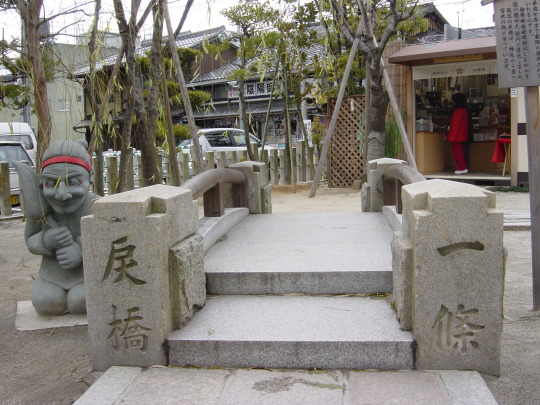
Ichijō-modoribashi in 2005, with the shikigami statue on the left (wikimedia commons)
It’s worth noting that the story seemingly had a degree of influence on the surroundings of Ichijō-modoribashi bridge. Today there’s a statue of a shikigami next to it. However, he’s not one of the Twelve Heavenly Generals, but rather an anonymous critter who appears in medieval portraits of Seimei as his personal shikigami. Compare the two depictions below, courtesy of wikimedia commons:


As for Abe no Seimei Monogatari, as thrilling as the summary of Rika’s character sounds, she sadly receives very little spotlight. We don’t learn how she met Seimei, where she came from, or the circumstances of their marriage. No information from the Genpei Jōsuiki episode is referenced, either, and I think it’s safe to say the two takes on Seimei’s wife are independent from each other - though it’s not hard to find people treating them as the same character online. To be fair, it’s not like these sources are impossible to reconcile with each other.
Rika and Seimei are already married when she is mentioned for the first time, when Seimei leaves to China to study under Hakudō Shōnin. In his absence Dōman, who after losing a bet had to become his disciple earlier, conspires with Rika (to be fair, Seimei for whatever reason entrusted him with taking care of her in his absence). His goal is to gain insight into two books Seimei owns: the Kin’u Gyokuto Shū, written by Hakudō Shōnin, and the Hoki Naiden, brought to Japan by Kibi no Makibi. She shows him a box in which Seimei keeps them. He wastes no time and after figuring out how to open it studies both books and copies them.
When Seimei returns, Dōman offers him a wager. He claims that the books were revealed to him in a dream by the bodhisattva Monju, and suggests that he can prove it. Seimei, who does not believe in dream visions, and remains blissfully unaware of Rika’s actions in his absence, agrees, and says that Dōman can kill him if he really does have the books - that’s how implausible this scenario is to him. To his shock, his rival-turned-apprentice reveals the copies he prepared, and in accordance with their agreement kills him. Dōman then gets rid of everyone else in Seimei’s household by turning them into pieces of straw and wood - the only exception is Rika. The two become a couple; the narrator notes this is something he has desired for a long while already, though as far as I can tell the novel doesn’t mention it at any earlier point. We don’t really learn anything about Rika’s views on the matter, sadly.
Dōman’s triumph is short-lived. Through an omen, Hakudō Shōnin learns that Seimei has died and arrives in Japan to resurrect him and let him avenge his death. He visits Dōman and, in a mirror of the trick he played on Seimei earlier, gets him to agree that he should be killed if it turns out Seimei is alive. Seimei, alive and well thanks to Hakudō Shōnin’s magical abilities, promptly appears to complete this wager. Rika attempts to hide behind a curtain to avoid a similar fate, but this proves to be unsuccessful. While she doesn’t make a similar bargain with Hakudō Shōnin, the narrator states that this is ultimately a just outcome. Both conspirators are then buried near the bank of the Gojō River, and that’s basically it for their role in the story. Neither portrayal of Seimei’s wife gained much notoriety in later works. I would assume the fact that through the Edo period ultimately it was the story of his parents that captivated the audience was a factor (it would be hard to explore his own relationships if most new stories had him as a 5-year-old), but this is entirely speculative.
As for modern authors: Yumemakura Baku, whose novels about Seimei contributed towards the development of the “onmyōdō boom” in popculture, acknowledged in an interview that the historical Seimei presumably did have a wife, but said he has no plans to explore this topic.

Makuzu (bottom left) from Okano's adaptation of Yumemakura's novels (MELODY; reproduced here for educational purposes only)
This being said, the manga adaptation of his works by Okano Reiko apparently did introduce a character loosely based on her Genpei Jōsuiki portrayal named Makuzu (真葛). The reception of this addition appears to be mixed, but as I haven't read this series I won’t pass judgment. This being said, if the Makuzu subplot really does involve Seimei learning they’re the reincarnation of a pharaoh and his wife out of blue, let’s just say I think I’d rather stick to Yumemakura’s prose version.
I was also able to find a single modern work which actually features Rika: Onmyōji Abe no Seimei - Saishū Kessen (陰陽師 安倍晴明ー最終決戦; “Onmyōji Abe no Seimei - Final Battle”) a very loose stage play adaptation of Abe no Seimei Monogatari by the troupe Gesshoku Kageki Dan (月蝕華撃團). A recording from 2021 can be found on their youtube channel:
youtube
Additionally there are numerous photos of the costumes on their social media (a selection of my favorites: 1, 2, 3, 4, 5). Parts of the plot seem… very avant garde compared to the original, but I do like the actress portraying Seimei, Shiranaga Ayumi (白永歩美), a lot. Note that Seimei isn’t supposed to be a woman here, though (this remains an idea largely exclusive to Fromsoft’s Kuon); this troupe’s performances pretty commonly involve actresses playing male roles, as I understand. Whether intentional or not, in this case it ends up as a neat parallel to men traditionally playing Kuzunoha in the Edo period and beyond.
Hakudō Shōnin

An illustration of Hakudō Shōnin from the Abe no Seimei Monogatari
Given that I already brought up Hakudō Shōnin (伯道上人; sometimes translated as “Saint Hakudō”) multiple times, I don’t think it’s particularly shocking that I consider him another character who warrants more spotlight. At least one Edo period source, Jinrin Kinmō Zui (人倫訓蒙図彙; “Illustrated Dictionary of Different Kinds of People”) from 1690, seems to treat him as a historical figure. The entry on diviners (占師, uranaishi) states that Kamo no Yasunori brought Chinese divination methods originally invented by Fuxi to Japan, but also that Abe no Seimei was taught them by Hakudō Shōnin. In reality, not only is Hakudō entirely fictitious, he didn’t even originate in China. In theory his name would be Bodao Shangren in Chinese - but no Chinese source actually mentions him. He is essentially a representation of the Japanese idea of what a Chinese Buddhist sage slash Daoist immortal (he is described as both simultaneously) would be like. In art he is seemingly generally portrayed in the garb of a monk. I’ve seen a single more unique depiction recently, but I was unable to verify its provenance:
It’s fair to say that in literature Hakudō Shōnin is portrayed as part ascetic, part onmyōji. This might seem unusual - after all, the historical Heian period onmyōji were essentially government officials not too different from other mid-level courtiers. However, Hakudō’s portrayal is not particularly outlandish - it reflects ideas about is onmyōji widespread in medieval sources. The fact that divinatory techniques associated with onmyōdō were often transmitted by shugenja - mountain ascetics - in this period is doubtlessly related, but I won’t pursue this point further here.
As far as literature goes, the merging of onmyōdō and asceticism is evident in legends about the legendary sage Hōdō Shōnin (法道上人, Sanskrit Dharmamārga) or the historical Tendai monk Jōzō (浄蔵). In the Kojidan (古事談), compiled by Minamoto no Akikane (源顕兼) around 1212-1215, even Seimei himself is described as a hermit who gained mastery of onmyōdō by leading an ascetic life in in Kumano (a particularly favored location for such activities) for a thousand days.
Given that this image of Seimei doesn’t really reemerge in later sources, I’m admittedly curious if perhaps Hakudō wasn’t created to offer an indirect way to incorporate it into broader informal “Seimei canon” - so that instead of Seimei gaining knowledge through asceticism, he instead acquired it from an ascetic? This is entirely speculative on my part, though. Note that there might very well be older sources mentioning Hakudō than those I am aware of, which depending on date could instantly sink this proposal.
Stories involving Hakudō were already in circulation in the fourteenth century. An early example appears in the preface to Hoki Naiden. It describes him as a disciple of the bodhisattva Monju who after attaining enlightenment received the scroll Monju Sesshū Butsurekikyō (“Sutra of Buddha Calendar Assembled by Monju”) from him. He then brought it with him to China, where he came up with a new title for it, Hoki Naiden Kin’u Gyokuto Shū . Many years later Seimei learned about it from him, and made it the to-go point of reference for fellow onmyōji in Japan under its full title. It should be noted here that another tradition had Seimei himself as the author, though. In reality it was most likely only composed in the fourteenth century by a hitherto unidentified descendant of the historical Seimei (or at least someone who saw association with him as a source of own credibility), though.
The Hoki Naiden preface also states that Hakudō arrived in Japan after Seimei’s death to resurrect him. To that end he collected all his bones - “12 big bones and 360 small bones altogether” - and performed a special ritual. Noriko T. Reider notes that this passage resembles a number of legends involving a historical figure either trying to create a new living being out of bones or other body parts (Minamoto no Morofusa and Saigyō in two separate tales from the Senjūshō), or encountering a person created this way (Ki no Haseo in Haseo Zōshi). The difference is obviously that Hakudō brings a specific dead person to life instead of creating a new living being, and that the deed is portrayed firmly positively. Still, given that all of these stories have been composed roughly in the same time period, it does seem fair to say we’re dealing with different takes on the same motif.
It’s worth noting that while Hakudō Shōnin is essentially absent from modern Seimei media - presumably since Seimei is, true to historical sources, usually portrayed as a disciple of Kamo no Yasunori (or, alternatively, his father Kamo no Tadayuki) - in the middle ages he was famous enough to even be referenced in at least one variant of one the most famous medieval Japanese works possible, namely in the Ōeyama Ekotoba (大江山絵���), a Muromachi period illustrated version of the Shuten Dōji legend. It puts a peculiar twist on the connection between him and Seimei, though. It is revealed that instead of being a disciple and a master, respectively, they are two incarnations of Ryūju Bosatsu (龍樹菩薩) - the bodhisattva form of the early Buddhist philosopher Nāgārjuna, venerated in Japan by the Shingon school.
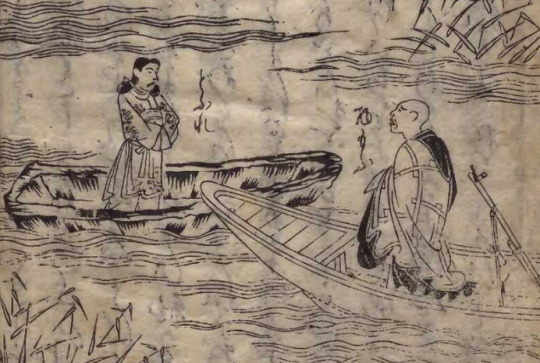
Hakudō encountering the bodhisattva Monju Both of the Hoki Naiden legends mentioned above were incorporated into Abe no Seimei Monogatari. An entire section of this novel is additionally dedicated to Hakudō’s early career and the origin of the Hoki Naiden. It states he was born during the reign of the Zhou dynasty (so he’s over a thousand years old - possibly nearly two thousand years old - by the time he meets Seimei), and that he initially lived in Jingshan. He tried to master yin, yang, earth and haven, but failed to do so. This prompted him to go on a journey, during which he encountered a supernatural youth - an incarnation of the bodhisattva Monju - who informed him that his approach was wrong. He let Hakudō become his disciple on Mt. Wutai (however, in the Hoki-shō his studies take place in India instead).
Under Monju’s guidance Hakudō managed to learn all of the mysteries he wanted to know, becoming a master of divination in the process. He also attained the rank of an arhat. He later returned to Jingshan, where he compiled the teachings of the bodhisattva revealed to him in 160 volumes.

Donfang Shuo (wikimedia commons)
Through the following centuries, Hakudō secretly revealed small snippets to various rulers and sages, including Jiang Ziya, Fan Li, Zhang Liang, Kong Anguo and Heshang Gong. The scrolls were eventually gifted to emperor Wu of Han, whose courtier Donfang Shuo (a veritable Han dynasty reneissance man) managed to become a great sage just by studying them (remember this detail, it will be relevant later).
As you can probably tell, the passage dealing with Seimei’s resurrection inspired the section of the story involving Rika, which I already summarized above.

Hōdō Shōnin in Abe no Seimei Monogatari As a side note, it’s worth pointing out that Abe no Seimei Monogatari also features Hōdō Shōnin in a small capacity. Somewhat confusingly, he is described both as a Daoist immortal and as a monk from India. Dōman claims to be his disciple to make himself appear greater than in reality, but in reality he merely inherited a book written by ancestor Ashiya no Suguri Kiyofuto (藍屋村主清太; as far as I know, a character invented for this novel), who encountered Hōdō Shōnin around 300 years prior to the events of the story. While this sounds like setting up further intentional parallels between him and Seimei, as far as I can tell it’s not implied that Hōdō and Hakudō were rivals, and the former otherwise appears chiefly in legends unrelated to Seimei - most commonly ones dealing with the foundation of Buddhist temples. It also needs to be noted that since this is a work following the traditional negative portrayal of Dōman, the narrator makes it clear that despite claiming to be Hōdō’s disciple and even dressing up like a monk (a possible allusion to the term for unofficial onmyōji I’ve already discussed, I assume?) he was impious and even committed unspecified crimes. Hakudō Shōnin also makes an appearance in Shinodazuma Tsurigitsune Tsuketari Abe no Seimei Shusshō. In this play Seimei meets him when he is ten years old. Hakudō gives him the Kin’u Gyokuto Shū. It is also revealed that in the past he met Seimei’s ancestor Abe no Nakamaro when the latter acted as an envoy in China. His resurrection ritual is also referenced: when in the final act of the play Dōman’s subordinates kill Seimei’s father Yasuna, he has to be resurrected using Hakudō Shōnin’s bone-gathering method. While as I already summarized earlier Yasuna’s final fate is quite similar in Ashiya Dōman Ōuchi Kagami, no reference is made to any Chinese sages - it’s just one of the many abilities young Seimei has already mastered.
Kibi no Makibi (and Abe no Nakamaro)

An Edo period portrait of Kibi no Makibi (wikimedia commons)
Unlike Rika, who you can at best call semi-historical (in that the real Seimei probably did have a wife) and Hakudō Shōnin, who is entirely fictitious, the final figure I’d like to introduce you to in this article, Kibi no Makibi (吉備真備; 695-775), was a real person. His accomplishments and postmortem career as a literary character would honestly be enough for a separate article - here I will only limit myself to a small handful of sources due to space constraints. Makibi famously traveled to China twice, first as a student and then as an ambassador, and between these two journeys spent around 20 years (around one fourth of his life!) on the mainland. He was considered unusually erudite, and was one of the foremost Japanese scholars of his era. Due to his renown he also held a number of prominent positions in the court, including the incredibly prestigious role of minister of the right (右大臣, udaijin); the only other scholar to ever attain this rank was Sugawara no Michizane.
Next to Seimei and Kamo no Yasunori, Makibi is also probably one of the most famous onmyōji in history - which is quite a feat given that he actually had next to nothing to do with onmyōdō in life. Early sources, such as Shoku Nihongi (797) and Miyoshi no Kiyoyuki’s (三善清行; 847-919) Iken Fūji Jūni Kajō (意見封事十二箇条, “Statement of Opinion on Twelve Matters”) agree that he was unusually skilled, and that in China he mastered many arts, including but not limited to Confucian classics, history, arithmetic, music, poetry, and calligraphy, but they don’t link him with onmyōdō at all.
It’s hard to tell when and why the shift in the perception of Makibi’s knowledge occurred, but he is already described as not just an onmyōji, but the founder of onmyōdō in Fujiwara no Akihira’s (藤原明衡; 989-1066) Shin Sarugōki (新猿楽記, “Account of the New Monkey Music”). Another example can be found in the Konjaku Monogatari, where Makibi is portrayed using his onmyōdō skills to pacify the vengeful spirit of Fujiwara no Hirotsugu. By the twelfth century, regarding Makibi as an onmyōji was common. This is evident in the works most relevant to this article, namely fictionalized accounts of his journey to China. The oldest of them, Kibi Nittō no Kan no Koto (吉備入唐の間の事, “Kibi’s Adventures in China”), is preserved in Ōe no Masafusa’s Gōdanshō (江談抄). A more vague account can be found in the Fusō Ryakki (扶桑略記, "Brief History of Fusang"), though it is likely a derivative of the Gōdanshō one.

Makibi (in black robes) and Chinese officials (all images from this scroll have been taken from the website of the Museum of Fine Arts Boston; reproduced here for educational purposes only)
Masafusa’s account of the journey also inspired the illustrated scroll Kibi Daijin Nittō Emaki (吉備大臣入唐絵巻, “Illustrated Adventures of Minister Kibi in China“), which was most likely commissioned by emperor Go-Shirakawa between the late 1170 and early 1180s. Like other similar contemporary works, Kibi Daijin Nittō Emaki has very little to do with historical reality. It relays that after arriving in China, Makibi was imprisoned by local officials, who feared that due to being exceptionally skilled he would make them look inept in comparison. To regain his freedom he had to overcome a series of trials.

Distinctly oni-like vengeful Nakamaro
Makibi's only ally is the vengeful spirit of Abe no Nakamaro (阿倍仲麻呂; 698-770). He is described as the previous ambassador. After a similar ordeal he died in captivity.
In reality, Nakamaro traveled to China alongside Makibi in 716. However, he was not an envoy, but merely a student who was allowed to join an official delegation. What is true is that he never returned to Japan. This was not the result of any nefarious plot, let alone premature death, though. He successfully completed the Chinese civil service exam and became an official. He did try to return to Japan in 735, but a storm left him shipwrecked at the coast of Annam (a part of modern Vietnam which at the time was a Chinese protectorate), and he opted to return to his career. He also attained some renown as a poet, and was on friendly terms with the poetic superstars of his times, Li Bai and Wang Wei. All around his real life was most likely happier than the story would indicate - though based on his surviving poetry it is safe to assume he did feel homesick in some capacity.

Nakamaro longing for home in Abe no Seimei Monogatari
Obviously, Kibi Daijin Nittō Emaki is a particularly extreme example of reinterpretation of Nakamaro’s life in literature postdating him. However, portrayals focused on his longing for a return home are quite common, and appear as early as in the Tosa Nikki (土佐日記, “Tosa Diary”) by Ki no Tsurayuki, completed around 935. It should be noted that by the tenth century or so, even venturing beyond the capital was commonly described as a daunting task, and dying in exile was one of the greatest fears for courtiers. Based on these developments, it can also be argued that the fictionalized portrayal of Nakamaro is an example of a phenomenon derived from these fears - the belief that people who died far away from home would return as vengeful ghosts. He could thus be considered a peer of the likes of Sugawara no Michizane or prince Sawara. The possibility that someone would move to a far off land voluntarily, and die there peacefully of natural causes, would probably be hard to grasp for late Heian audiences.
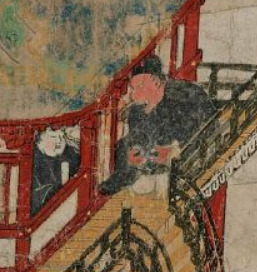
Pacified Nakamaro (right) talking to Makibi (left)
Anyway, back to the story. Makibi’s captors are actually convinced that Nakamaro, who became a vengeful spirit and haunts the tower where the new envoy ends up imprisoned, will kill him. However, even though Nakamaro appears to Makibi in a fierce oni-like form, he ends up pacified through what might be an unusual ritual. Makibi informs him that he is in the presence of an official envoy, and as such needs to take a suitable form. This evidently works - through the rest of the scroll Nakamaro, now a staunch ally of Makibi, is depicted in the attire of a Japanese official, just with an unconventional distinctly orange skin tone. Makibi also learns that Nakamaro is concerned about his relatives, and reassures him that his entire clan is doing well.

Makibi and Nakamaro flying After surviving the encounter with Nakamaro, Makibi is informed that his trials are set to begin. The first of them involves learning the Wen Xuan (文選, “Selections of Refined Literature”). He is not familiar with this anthology, but using a secret art enabling him to fly he manages to secretly reach the imperial palace to listen to scholars reading it. In the illustrated version he masters flight himself, which is presumably meant to show he is in full control of the situation, and there is no genuine threat in his temporary captivity. However, in Masafusa’s forerunner it is Nakamaro who can fly, and Makibi relies on his help. Either way, the aerial journey is successful, and when a Chinese official appears to question Makibi, he reveals a copy of Wen Xuan he prepared in secret based on what he heard, thus completing the first challenge.

Makibi playing go The next day, Makibi is set to face a master of go. This might seem random, but playing it was a fairly standard part of diplomatic visits, and in fact in at least some cases envoys were selected based on their go skills. Makibi is unfamiliar with it, though, and has to learn the rules from Nakamaro. He quickly comes up with an ingenious, if unconventional, strategy. Initially neither side gains an advantage, but eventually Makibi notices an opportunity to use his secret gambit arises He swallows one of his opponent’s pieces, which lets him attain victory. A diviner informs the Chinese officials about this, and they tell Makibi to take a purgative to prove he was cheating, but he manages to counter its effects with his esoteric knowledge.
Makibi’s success infuriates the officials, and they decide that to hinder him they’ll try to starve him. He manages to overcome this hardship with the help of Nakamaro, who secretly brings him food every night. This continues for months, but eventually the time of another challenge comes.
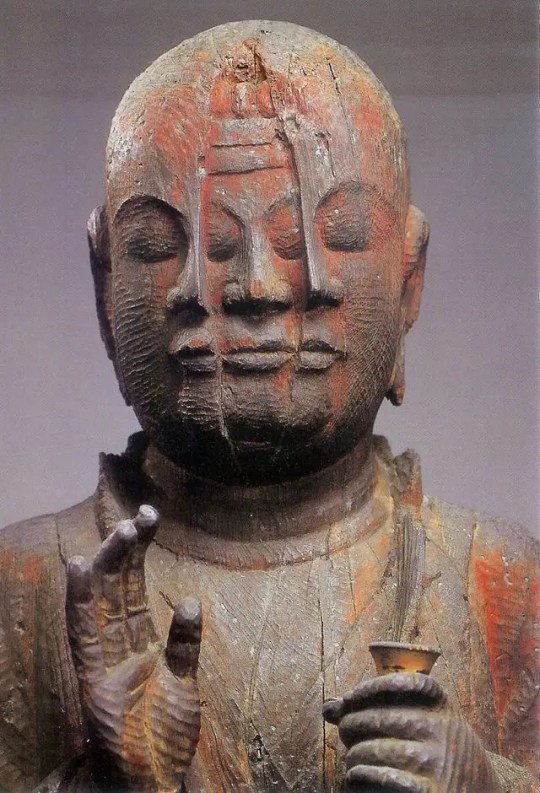
A statue from Saiō-ji depicting Baozhi revealing his nature as an incarnation of the bodhisattva Avalokiteśvara (Kyoto National Museum; reproduced here for educational purposes only)
As it turns out, the officials decided to seek the help of a virtuous Buddhist monk, the Chan master Baozhi (宝志禅师; he actually lived during the reign of Wu of Liang, some 250 years before Makibi’s journey), who prepared a barrier meant to prevent supernatural beings from entering the palace where Makibi will be tested. This means that for the first time he will have to manage without any help from Nakamaro. His new task to interpret a complex poem, Yabatai (邪馬台). Its contents aren’t discussed in the story; it was a purported prophecy according to which Japan will undergo division and ultimately perish after the reign of the hundredth emperor. Needless to say, following the traditional order which includes mythical and legendary emperors, the prophecy evidently didn’t come to pass - Go-Komatsu was #100, Naruhito is #126. Makibi initially cannot even decipher a single sign. In despair, he prays to Sumiyoshi and Kannon of Hasedera. A spider miraculously appears, and moves across the text to help him read it properly. The gathered officials, as well as the Chinese emperor, are in awe. However, they don’t let Makibi return home, and once again lock him in the tower.
Shortly afterwards, Makibi is reunited with his ally Nakamaro, and enlists his help once more. He asks him to find a century old set of sugoroku paraphernalia. With the help of these tools, he causes an eclipse. The emperor learns about its cause from his diviners, and has his officials question Kibi. He claims that the only way to end the eclipse is to let him return to Japan. This time, they oblige, and the story ends. The forerunner preserved by Masafusa indicates that Makibi was also credited with bringing the Wen Xuan, the Yabatai and the game of go to Japan. In reality, go and Wen Xuan were already known in Japan before his journey. Meanwhile, according to the Edo period philosopher Hayashi Gahō Yabatai was most likely a hoax composed in Japan in the Heian period, even though it was held to be the work of Baozhi.
It is commonly assumed in scholarship that the story was meant to reflect somewhat xenophobic attitudes towards China or more broadly towards foreign lands prevalent at the time of its composition. While in Makibi’s and Nakamaro’s times sending envoys to China was relatively common, and Japanese emperors actively sought contact with their Chinese counterparts (though occasionally diplomatic correspondence could end up awkward as both sides aimed to present themselves as superior), with time similar journeys became less frequent, and started to be perceived as increasingly dangerous (to be fair - the risk of getting shipwrecked was genuinely fairly high). It might be significant that formal diplomacy resumed during the reign of Go-Shirakawa, though. It is distinctly possible that he saw this success as a parallel to Makibi’s legendary deeds, and commissioned an illustrated edition to basically congratulate himself.
An alternate proposal is that Kibi Daijin Nittō Emaki arose as a part of an onmyōdō feud between the Kamo and Abe clans. For what it’s worth, it does seem that despite earlier successful arrangements meant to guarantee a division of positions in the court both the Abe and the Kamo would be satisfied with, tensions arose between them during reigns of emperors Toba and Go-Shirakawa, so roughly at the time of its composition. However, the interpretation of the story as a product of this conflict rests on the argument that Makibi is portrayed as more clever and skilled than Nakamaro. This sort of power level discussion is not entirely rooted in the primary sources, where the two clearly work as a team. There are further problems with this interpretation, too.
An obvious issue is that while the link between Abe no Nakamaro and the Abe clan is self-explanatory, it is not exactly evident in which way Makibi would be a representation of the Kamo. It is sometimes claimed in scholarship that the Kamo clan claimed descent from him, but this appears to be an Edo period misconception. It’s most likely a result of confusion between Kamo no Kibimaro (鴨吉備麻呂), a member of the Kamo clan who also traveled to China (his journey occurred earlier, during the final years of the reign of Wu Zetian), and Makibi. No reference to a relation between Makibi and the Kamo can be found in the fourteenth century genealogical treatise Sonpi Bunmyaku (尊卑分脈; “Genealogical Branches of the High and the Low”), though. Kamo no Yasunori is essentially treated as the founder of this lineage. A further problem is that there’s no good reason to doubt that the scroll was prepared for emperor Go-Shirakawa - who himself favored the Abe clan, as evidenced by the esteem Abe no Yasuchika (安倍泰親) enjoyed in his court.
Kibi Daijin Nittō Emaki wasn’t commonly copied in the Kamakura and Muromachi periods, but portraying Makibi as an onmyōji only became more entrenched in literature over the middle ages. He was supposedly responsible for transmitting rituals focused on Tenkeisei (天刑星, “Star of Heavenly Punishment“; this deity was held to be a master of all shikigami, for more info see my previous article) alongside Kamo no Yasunori. In a local tradition from Mount Hiromine, he was credited with enabling the enshrinement of Gozu Tennō by making a pact with him during his journeys to China.
While the examples cited above were essentially new, the specific story illustrated in Kibi Daijin Nittō Emaki evidently wasn’t forgotten either. It regained popularity in the Edo period, as evidenced by its various new adaptations. These include works from various genres, such as Koikawa Harumachi’s novel Kibi no Nihon Jie (吉備能日本知恵, “Japanese Kibi’s Ingenuity”) or the kabuki play Kibi Daijin Shina Tan (吉備大臣支那譚, “Story of Minister Kibi in China”). However, from the perspective of this article what matters the most is that it was incorporated into Abe no Seimei Monogatari, thus firmly becoming a part of Seimei’s origin story.
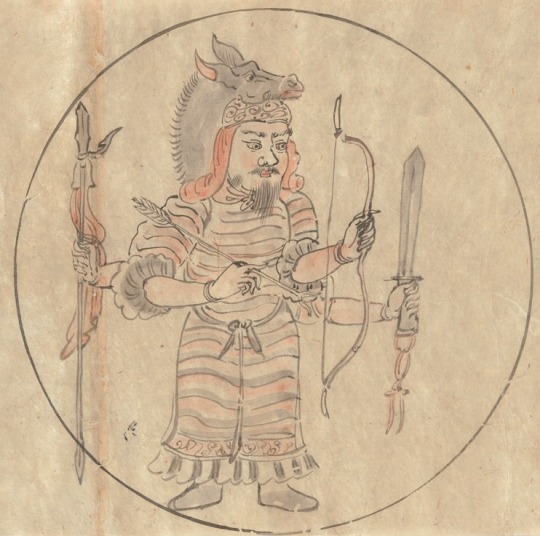
A personification of Mars, as depicted in Sōkan’s Iconographic Drawings of the Secrets of the Nine Luminaries (public domain; via Metropolitan Museum of Art)
The novel introduces Abe no Nakamaro first, and reveals that he was the reincarnation of Dongfang Shuo (remember him?) and by extension of the planet Mars (sic). Since Dongfang Shuo was incredibly loyal to his country, it was only natural the same was true for his reincarnation. However, as Nakamaro was born in Japan, and not China, this was less than optimal in the specific situation he found himself in. After arriving in China as an envoy, he was imprisoned - as described in earlier works - because his actions were perceived as disrespectful. He dies in prison shortly after.
A year after Nakamaro’s ill fated journey, Kibi no Makibi arrives in China as the next envoy. The Chinese emperor, Xuanzong, is infuriated that the tribute he presented was inadequate, and considers executing him, but decides to give him a way out. If he can complete a series of trials, he will be allowed to return to Japan instead (inadequate tribute be damned). These overlap with the earlier versions, though the order is changed.
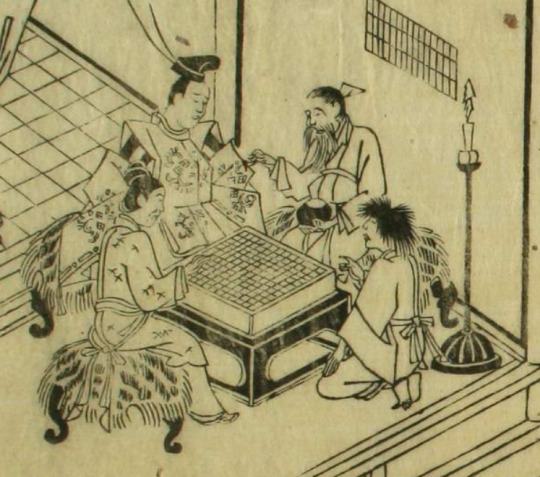
Makibi playing go in Abe no Seimei Monogatari
The first of the trials involves go. Makibi is set to face a master of this game, a certain Xiandang (玄東; Gentō in Japanese) in it. His opponent actually doesn’t have a name in any of the early accounts of his adventures in China; it seems this was an innovation of an abbreviated version from the Hoki-shō.

The fateful go match, as imagined by Kunisuda Utagawa; note the inclusion of Xiandang's wife (Egenolf Gallery; reproduced here for educational purposes only) The name evidently caught on, though, since in addition to Abe no Seimei Monogatari it also pops up in other Edo period works, such as the 1852 kabuki play Kin’u Gyokuto Wakoku no Irifune (金烏玉兎倭国入船, “The Golden Crow, the Jade Rabbit, and the Ship that Arrived from Japan”). The resolution also differs somewhat: Makibi learns go by secretly observing Xiandang, who plays it regularly with his wife at home. He wins two matches against him fair and square, without the need to eat any of the pieces.
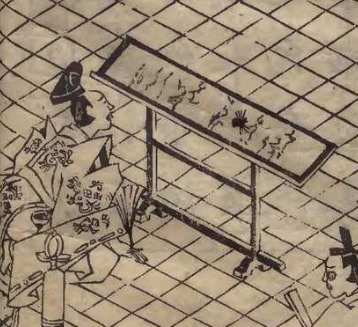
A spider helps Makibi
The Wenxuan trial is next; it essentially goes the same as in Kibi Daijin Nittō Emaki. The Yabatai trial is altered slightly, though. For starters, Bao Zhi is not physically present - he is only referenced as the poem’s supposed author. The emperor selects it specifically because it’s uniquely difficult, and he can’t read it himself. Nakamaro learns about this, and tells Makibi the best solution might be to pray, which he promptly does. No reference is made to Sumiyoshi, but Kannon of Hasadera gets a more prominent role. Makibi’s devotion to this figure is stressed over and over again. The spider whose help lets him read Yabatai is explicitly identified as a manifestation of this bodhisattva, as well. Reading Yabatai is presented as a grand feat. The entire court cheers (a far cry from the excessively villainous portrayal of courtly officials in Kibi Daijin Niitō Emaki). Even the emperor is deeply moved by Makibi’s skill, and instead of simply letting him go back home as he initially intended he tells him that he can stay as long as he wants in China in order to study. This seems like an attempt at reconciling fictional portrayals of Makibi’s journey with historical reality - I must say I think it works pretty well.
In any case, Makibi accepts the offer, and spends a long time studying various arts in China, much like he did in real life. When he finally decides to return to Japan, Xuanzong bestows various gifts on him, including a variety of literary texts, musical instruments, relics of the Buddha, a robe made from the hide of a “fire-rat” (火鼠, huoshu in Chinese, kaso in Japanese; Makibi could thus complete at least one of the trials of princess Kaguya if he only met her) and, most importantly, the Hoki Naiden (presumably passed down from emperor to emperor, though the story doesn’t state it explicitly). He also ordered a thousand monks to pray to guarantee his voyage back home would be safe.
The Abe no Seimei Monogatari account of Makibi deeds doesn’t end here, in contrast with Kibi Daijin Nittō Emaki. He safely returns to Japan, and the emperor bestows prestigious positions upon him as a reward for his accomplishments in China. Many years later, as an elderly man, he starts feeling like he essentially ended up with a life that should’ve been Nakamaro’s, though (somewhat confusingly, Nakamaro makes no physical appearance after the trials), and decides to find his family. He is unsuccessful, and ultimately writes in his will that he wants his own descendants to seek Nakamaro’s to give them the Hoki Naiden. As it later turns out, they have fallen into poverty, and have no real use for this tome. It ends up hidden until the birth of Abe no Seimei many years later.
The same events are described differently in the Hoki-shō. Makibi acquires the Hoki Naiden basically through the same means as in Abe no Seimei Monogatari, but after returning from China he gives it to young Seimei, who is introduced as a descendant of Nakamaro. In reality, despite sharing the same family name Nakamaro and Seimei were not directly related, though (Abe no Seimei Monogatari approaches this issue slightly differently, by having Seimei be a reincarnation of Nakamaro,as revealed by Hakudō). Furthermore, comparing the dates of Makibi’s journey and Seimei’s birth makes any encounter between them chronologically awkward.
It seems in at least some other works Makibi had one more role to play in setting up Seimei’s career: supposedly Kuzunoha (or, at the very least, Shinoda Myōjin) could be portrayed as his reincarnation. The problem is, while I have no reason to doubt the authenticity of this tradition, I can’t pinpoint its original source for now - this is in part why this article took so long to release.
More than once I’ve seen an assertion that it comes from a sekkyobushi, but as I outlined earlier, it seems no actual evidence for the existence of such an adaptation is available. Furthermore, the most prominent online source of this claim is seemingly a blog on which I also found posts uncritically discussing Hotsuma Tsutae and JJCAT - which doesn’t exactly fill me with optimism. In the article Kitsunenyōbō Ni Miru Ikai ― Futari no Kuzunoha Ga Deau Koto ― Atsuko Katō states that the notion of Shinoda Myōjin being a reincarnation of Kibi no Makibi comes from Abe no Seimei Monogatari, but either this is a mistake, or for some strange reason a scene was omitted in Nana Miyata’s recent German translation (Die Erzählungen vom Leben und Wirken des Divinationsmeisters Abe no Seimei); unless the reference is actually to be found in the supplement to Abe no Seimei Monogatari which had the form of a divination manual, which is left out of the translation. Finally, the Kuzunoha article from Japanese Wikipedia gives the source as Shinodazuma Tsurigitsune Tsuketari Abe no Seimei Shusshō, relying on an anthology of Edo period puppet plays from 1965, edited by Shigeru Yokoyama. Sadly, I can’t consult the full text of this work to verify. I’ll update this article if I ever manage to solve this conundrum. Until then, though, it must end on a slightly unsatisfying note. Bibliography Tumblr for some unfathomable reason didn't let me include a bibliography here, so sadly you have to visit a google doc to access it. I'm sorry.
#kuzunoha#abe no seimei#japanese literature#onmyōdō#onmyōji#ashiya dōman#ashiya douman#kibi no makibi#abe no nakamaro
90 notes
·
View notes
Note
Nakamaro feels like another cope by people who don't want the emo twink to be Seimei imo, but it's probably the cope with the most basis since Yang Guifei's Related Characters establish Meteo wants to write Nakamaro sooner or later, and because the "Yasuhiro uses himself as a catalyst to summon his ancestor" gimmick idea also applies to Nakamaro. I just don't think this is the context to bring him since Yang Guifei is not in the game.
But here's a brief look at who Nakamaro was just so the possibility can be properly explored by people who want to believe it.
Historical biography:
Nakamaro was talented from a young age, so when he turned 20, he was chosen as an exchange student sent to study China's civilization and bring their advanced knowledge back to Japan. He passed the ultra-difficult government employment exam (see Wu Zetian's interlude for commentary on how challenging the exams were) and started working for Emperor Xuanzong. He became friends with the other major poets of the time and taught Yang Guifei everything she knew about Japan (Nasuverse canon-certified fact).
35 years later, he tried to return to Japan and an oceanic storm crashed his ship on the coast of Vietnam. Took him 3 years to return to the Chinese capital, and from there he gave up on returning to Japan and spent the last 15 years of his life sulking about his impossible dream of returning home and writing a lot of poetry about how he misses Japan.
Mythological biography:
Before leaving Japan, Nakamaro supposedly fathered a boy named Mangetsumaru. 200 years down the line, one Abe no Seimei would be born as Mangetsumaru's descendant. There are at least 3 sources saying Mangetsumaru existed, but no hard evidence yet.
Anyways, legends tell that Emperor Ganshou wanted someone to go to China, borrow the Kin'ugyokutoshuu (Seimei's second most famous spellbook) from Emperor Xuanzong, and bring it to Japan. Fujiwara no Fuhito recommended Nakamaro for the job, so the young man was sent on this magical secret mission. Emperor Xuanzong quickly took notice of Nakamaro's talents and put him on a lot of important work. After 14 years of successful work, Xuanzong's chief vassals (Guifei's cousin and Guifei's adopted son) couldn't stand him anymore, so they got him drunk and locked him in a tall tower. There he died of anger and starvation and his corpse turned into an oni seeking the spellbook he was sent to get.
Meanwhile, the Emperor of Japan heard the news about Nakamaro's quick climb up the promotion ladder in China's court, assumed he betrayed his mission and abandoned his nation, and confiscated Nakamaro's land. Kibi no Makibi was sent to China to get the spellbook in his place. Learning about Makibi, Nakamaro-turned-oni helped his substitute in his mission, advising him on how to decipher prophecies and win board game tournaments. With oni Nakamaro's continued help, Makibi succeeded in bring the spellbook to Japan, and later it went to hands of Nakamaro's famed descendant Seimei.
Samu R's Caster could be Abe no Nakamaro.
I don't know anything about him, what makes you say so?
9 notes
·
View notes
Photo
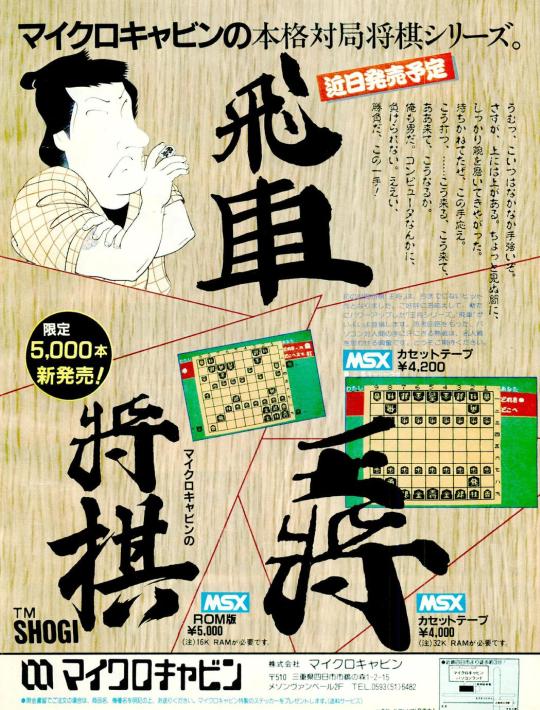
‘Shogi‘ [将棋]
[MSX] [JAPAN] [MAGAZINE] [1985]
“It is not clear when the ancestral chess-type game that later developed into shogi was brought to Japan. This is in contrast to the game of go, which was almost certainly brought to Japan in or around the Nara period, since a go board is stored in the treasury of Shōsōin (正倉院). There are tales that relate that it was invented by Yuwen Yong of Northern Zhou, and that Kibi Makibi (吉備真備) brought it back after visiting the country of Tang, but both these tales are likely to have been invented at the start of the Edo period by those keen to make a name for themselves as authorities on shogi.
There are several theories about when shogi spread to Japan, but the earliest plausible date is around the 6th century. It is thought that the pieces used in the shogi of the time were not the current five-sided pieces, but three-dimensional figures, as were used in chaturanga. This parallels the changes in chess pieces, which are more representational and less abstract than those made earlier. However, a large problem with this theory is that as pieces in this form have never been found, let alone stored in the treasury of Shōsōin, there is little physical evidence supporting it.
Another theory gives a later date, stating that shogi was brought to Japan after the start of the Nara period. However, serious doubts about this theory remain as these games are different from shogi – for example, in that pieces are placed on the intersections of lines. The games of makruk from Thailand and Cambodia and sittuyin from Myanmar have an elephant which moves in the same way as the silver general. Sittuyin also has the practice of dropping pieces. From the Song Dynasty through the Ming Dynasty, China sent great trade convoys through the southern islands and all around the Indian Ocean and also traded with Japan, so elements of South Asian chess could have reached Japan.” ~Wikipedia
Source: MSX Magazine, June 1985 || Internet Archive; msxmag
13 notes
·
View notes
Photo

Inktober Day 3- Tamamo no Mae
Beautiful evil...
Tamamo no Mae is one of the most famous kitsune in Japanese mythology. A nine-tailed magical fox, she is also one of the most powerful yōkai that has ever lived. Although she may not have succeeded in her plan to kill the emperor and take his place, her actions destabilized the country and lead it towards one of the most important civil wars in Japanese history. For that reason, Tamamo no Mae is considered one of the Nihon San Dai Aku Yōkai—the Three Terrible Yōkai of Japan.
Read more:
Tamamo no Mae was born some 3,500 years ago in what is now China. Her early life is a mystery, but she eventually became a powerful sorceress. After hundreds of more years she became a white faced, golden furred kyūbi no kitsune—a nine-tailed fox with supreme magical power. In addition, she was an expert at manipulation. She used her charms and wit to advance her standing and influence world affairs.
During the Shang Dynasty Tamamo no Mae was known as Daji. She disguised herself as a beautiful woman and became the favorite concubine of King Zhou of Shang. Daji was a model of human depravity. She held orgies in the palace gardens. Her fondness for watching and inventing new forms of torture are legendary. Daji eventually brought about the fall of the entire Shang Dynasty. She managed to escape execution, and fled to the Magadha kingdom in India in 1046 BCE.
In Magadha, she was known as Lady Kayō, and became a consort of King Kalmashapada, known in Japan as Hanzoku. She used her beauty and charms to dominate the king, causing him to devour children, murder priests, and commit other unspeakable horrors. Eventually—whether because she ran out children to eat or because Kalmashapada began to turn away from her and towards Buddhism—she fled back to China.
During the Zhou Dynasty she called herself Bao Si, and was known as one of the most desirable women in all of China. In 779 BCE she became a concubine of King You. Not satisfied as just a mistress, she manipulated the king into deposing his wife Queen Shen and making Bao Si his new queen. Though she was beautiful, Bao Si rarely ever smiled. In order to please his beautiful new wife, King You committed acts of such evil and atrocity that eventually all of his nobles abandoned and betrayed him. Eventually, King You was killed and Bao Si captured and the Western Zhou Dynasty was brought to an end in 771 BCE. Somehow Bao Si managed to escape again; she went into hiding for many years.
Little is known of her activities until the 700s, when she resurfaced disguised as a 16-year old girl named Wakamo. She tricked the leaders of the 10th Japanese envoy to the Tang Dynasty—Kibi no Makibi, Abe no Nakamaro, and Ganjin—as they were preparing to return home to Japan. Wakamo joined their crew and took the ship to Japan, where she hid herself away for over 300 years.
In the 1090s, she resurfaced once again. This time she transformed herself into a human baby and hid by the side of the road. A married couple found the baby and rescued it, taking her in as their daughter and naming her Mikuzume. She proved to be an exceedingly intelligent and talented young girl, and was so beautiful that she attracted to attention of everyone around her. When she was 7 years old, Mikuzume recited poetry before the emperor. His imperial majesty immediately took a liking to her and employed her as a servant in his court.
Mikuzume excelled at court, absorbing knowledge like a sponge. There was no question she could not answer, whether it was about music, history, astronomy, religion, or Chinese classics. Her clothes were always clean and unwrinkled. She always smelled pleasant. Mikuzume had the most beautiful face in all of Japan, and everyone who saw her loved her.
During the summer of her 18th year, a poetry and instrument recital was held in Mikuzume’s honor. During the recital, an unexpected storm fell upon the palace. All of the candles in the recital room were snuffed, leaving the participants in the dark. Suddenly, a bright light emanated from Mikuzume’s body, illuminating the room. Everybody at court was so impressed by her genius and declared that she must have had an exceedingly good and holy previous life. She was given the name Tamamo no Mae. Emperor Toba, already exceedingly fond of her, made her his consort.
Almost immediately after she became the emperor’s consort, the emperor fell deathly ill. None of the court physicians could determine the cause, and so the onmyōji Abe no Yasunari was called in. Abe no Yasunari read the emperor’s fortune and divined that he was marked by a bad omen. After that, the highest priests and monks were summoned to the palace to pray for the emperor’s health.
The best prayers of the highest priests had no effect, however. The emperor continued to grow worse. Abe no Yasunari was summoned again to read the emperor’s fortune. This time, to his horror the onmyōji discovered that the emperor’s beloved Tamamo no Mae was the cause of his illness. She was a kitsune in disguise, and was shortening the emperor’s life span in order to take over as ruler of Japan. Emperor Toba was reluctant to believe the diviner’s words, but agreed to test Tamamo no Mae just to be sure.
To save the emperor’s life, Abe no Yasunari prepared the Taizan Fukun no Sai, the most secret and most powerful spell known to onmyōdō. Tamamo no Mae was ordered to perform part of the ritual. They reasoned that an evil spirit would not be able to participate in such a holy ritual. Though she was reluctant to participate, the emperor’s ministers persuaded her. They told her that it would increase her standing an admiration among the court. She had little choice but to accept.
When the ritual was performed, Tamamo no Mae dressed even more beautifully than normal. She recited the holy worlds as expected and played her part extremely well. But just as she prepared to wave the ceremonial staff, she vanished. Abe no Yasunari’s divination was confirmed. The court flew into an uproar.
Soon after, word arrived that women and children were disappearing near Nasuno in Shimotsuke Province. The court sorcerers determined that Tamamo no Mae was the cause, and it was decided that she must be destroyed once and for all. The emperor summoned the best warriors in all of the land and then charged the most superb of them, Kazusanosuke and Miuranosuke, to find Tamamo no Mae. The warriors gladly accepted the honor. They purified themselves and set out with an army of 80,000 men to slay the nine-tailed kitsune.
Upon reaching Nasuno the army quickly found the kitsune. The warriors chased her for days and days, but the fox used her magical powers and outsmarted them time and time again, easily escaping. The army grew weary, and frustration set in. It seemed that nothing they did was working. However, Kazusanosuke and Miuranosuke would not accept the shame of defeat and vowed to press on. They practiced harder, honing their tactics, and eventually picked up the kitsune’s trail.
One night, Miuranosuke had a prophetic dream. A beautiful young girl appeared before him, crying. She begged: “Tomorrow I will lose my life to you. Please save me.” Miuranosuke adamantly refused, and upon waking the warriors set out again to find Tamamo no Mae. Sure enough, the next day they caught her. Miuranosuke fired two arrows, one through the fox’s flank and one through its neck. Kazusanosuke swung his blade. It was over, just as the dream had said.
However, Tamamo no Mae’s evil did not end with her death. One year after she died, Emperor Konoe died, heirless. The following year, her lover and former Emperor Toba died as well. A succession crisis ignited between forces loyal to Emperor Go-Shirakawa and forces loyal to former Emperor Sutoku. This crisis started the Fujiwara-Minamoto rivalry that led to the Genpei War, the end of the Heian period, and the rise of the first shoguns. As if that were not enough, Tamamo no Mae’s spirit haunted a massive boulder which killed every living thing that touched it. (from Yokai.com)
#tamamo no mae#kitsune#japanese folklore#inktober#inktober 2018#japanese#Japan#japanese culture#yokai#original art#my art#still behind but whatever
590 notes
·
View notes
Note
Sleep-deprived anon here, it was 3 or 4 in the morning I think. And yes, I was referring to him, we are in the same wave :D although in promos he was alter ego, now he is caster?? youtu. be / KtP818nabTI . At least he was related to Abe, it's something I suppose XD. Thank you so much for the info!! Love your blog ;D
No problem, and please do get more sleep if possible ==lll
Yes, Alter Ego is his true class from what he hinted in Shimosa Singularity. His skillset and even Noble Phantasm remains unknown as of now. But for his history, the closest I know of him is from here:
Abe no Seimei’s chief rival was a sorcerer from Harima named Ashiya Dōman. Dōman was much older than Seimei, and believed that there was no one in the land who was a better onmyōji than he was. Upon hearing of Seimei’s genius, he challenged him to a magical duel.
Three challenges he gave to Seimei, Douman lost to all of them and was completely humiliated.
Ashiya Dōman continued to hold a grudge against Abe no Seimei, and continued to plot against him. He seduced Seimei’s wife and convinced her to tell him Seimei’s magical secrets. She showed him the stone box in which Seimei kept Hoki Naiden, his book of spells. Hoki Naiden was a book of secrets which had been passed down since time immemorial from India to Tang, China. It came into the possession of the Japanese envoy, Kibi no Makibi. When Kibi no Makibi returned to Japan from Tang, he presented the secret book to the relatives of his friend Abe no Nakamaro, who remained in China. From there it was passed down and eventually inherited by Abe no Seimei. (I bold that part if assuming Nasu did follow this part of the history and that’s what Douman is so fixated on in India Lostbelt right now)
One night when Seimei returned home, Dōman boasted that he had acquired Seimei’s secret magic book. Seimei scolded him, saying that was impossible. So impossible, in fact, that if Dōman did have the book, he could cut Seimei’s throat. Dōman triumphantly presented the book, and Seimei, realizing that he had been betrayed by his wife, offered his throat to Dōman. Dōman gladly cut it open. Seimei died.
Seimei was then revived by Saint Hokudō after collecting his ashes and bones. Both of them went back to Seimei’s old home where he promptly cut open Douman’s and his now ex-wife’s throat after Hokudo called him to appear when Douman didn’t believe Hokudo saw Seimei alive when he murdered him
This one is not really accurate but does make me curious if Seimei is going to be next living Servant since he’s technically alive again, and he’s also famous for his Taizan Fuukuin Ritual…
But Douman, I can hardly find anything about him… Kinda guessing historian who wrote about Seimei didn’t find him much importance, or just that Seimei’s whole life is still shrouded in mystery
#the shit I shit myself into#asks & answers#i'm not kidding as even wikipedia hardly has any information about him#seimei is still shrouded about him#ashiya douman is like someone barely existed or something
14 notes
·
View notes
Photo
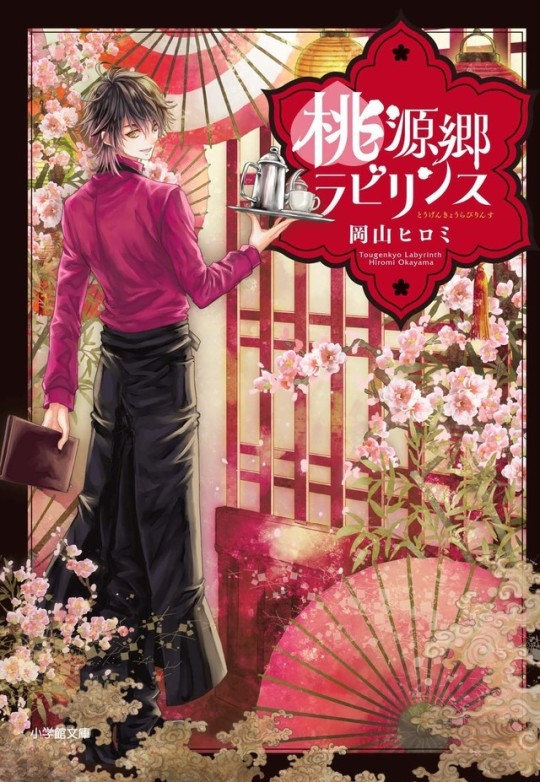
[Update] 舞台「桃源郷ラビリンス」(butai tougenkyou labyrinth)
cast & visuals update under the cut^^
Cast:

Torigoe Yuuki as Kibi Momotarou (吉備桃太郎)

Takahashi Kensuke as Yamamoto Takeru (大和尊)
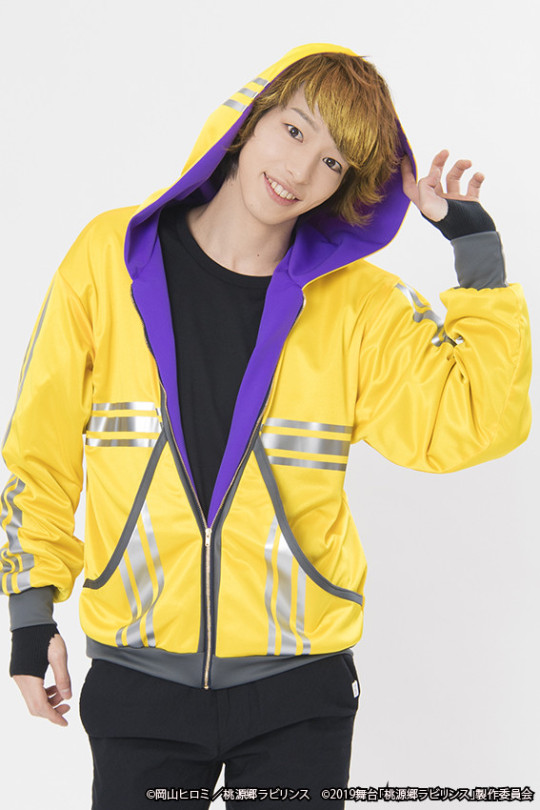
Sugie Taishi as Inukai Tsuyoshi (犬養津与志)

Asuma Kousuke as Sasamori Rui (楽々森類)

Yamamoto Ikkei as Tamaomi Juri (珠臣樹里)

Nagae Ryouki as Sakata Ginga (坂田銀牙)

Kento as Urashima Ukai (浦島雨海)

Kawakami Shouta as Shutendouji (酒呑童子)

Imade Mai as Ibarakidouji (茨木童子)
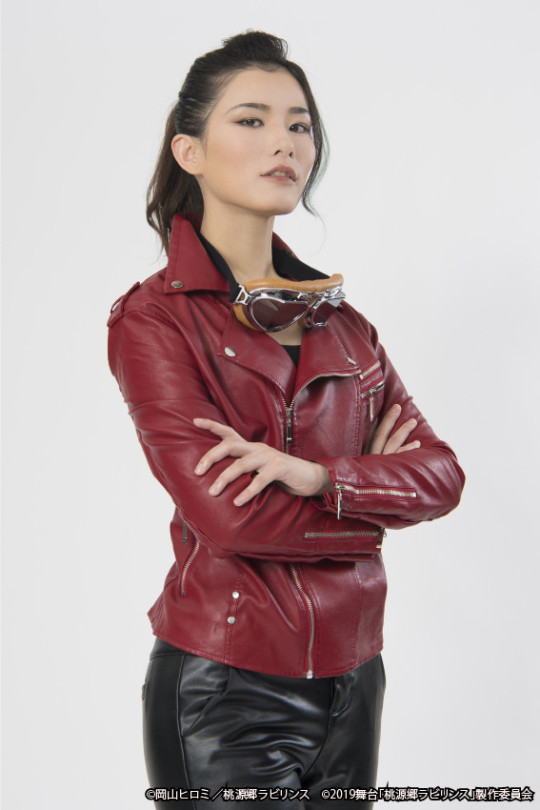
Shiotsuki Shuu as Watanabe no Tsuna (渡辺綱)
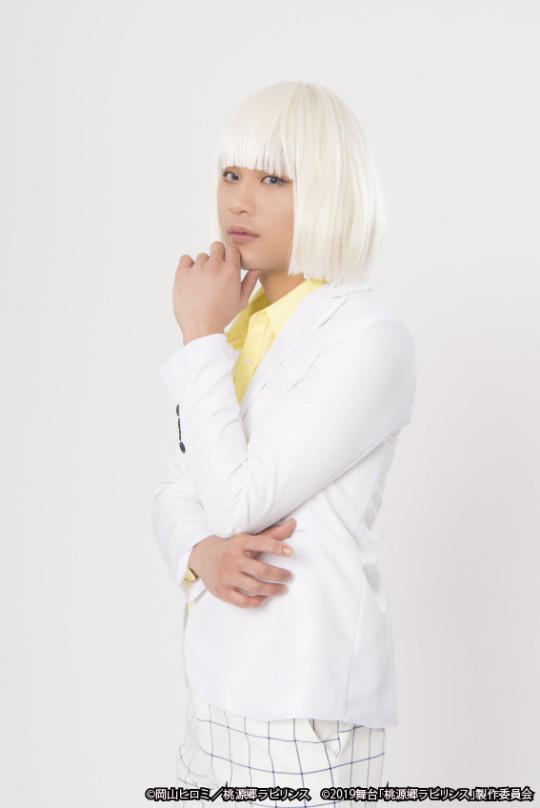
Ujiie Ren as Minamoto no Monjumaru (源文殊丸)

Miyamoto Hidemitsu as Urabe no Suetake (卜部季武)

Kurihara Taiga as Tachibana Sadamitsu (橘貞光)
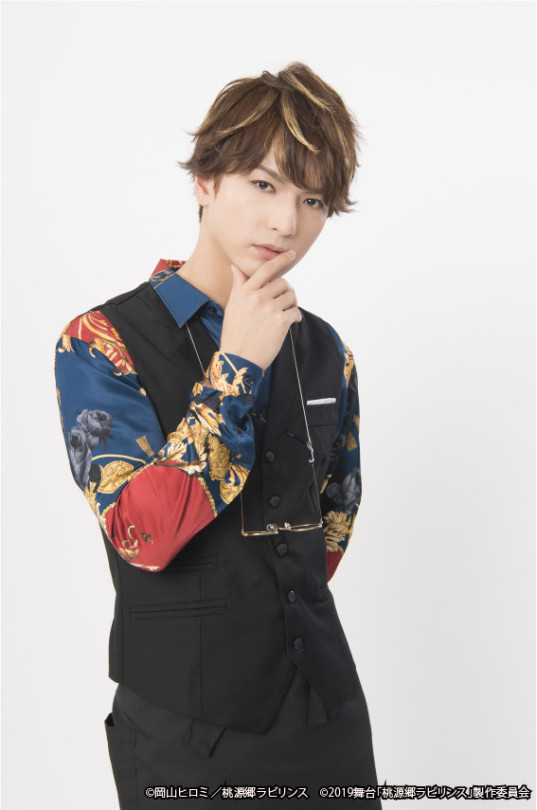
Nakamura Yuuichi as Kibi Makibi (吉備真備)
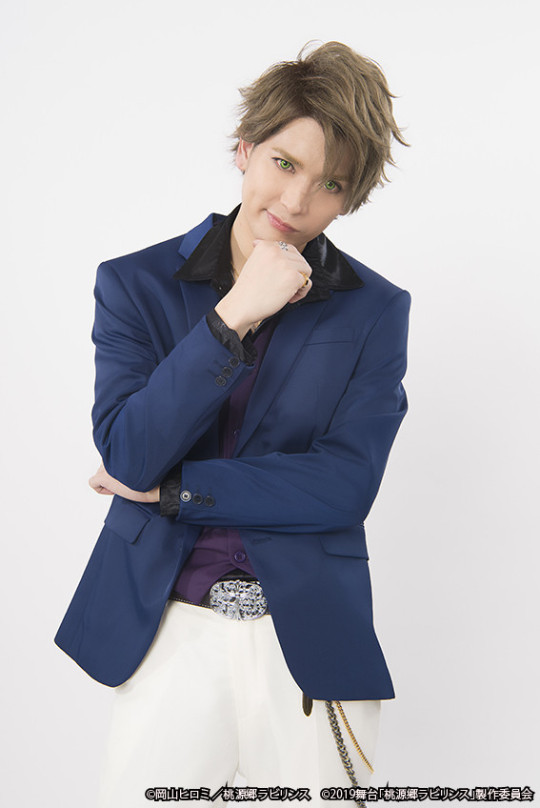
Nakada Hiroki as Martin Baird (マーティン・ベアード)

Kaneko Noboru as Abraham D Stoker (エイブラハム・D・ストーカー)
homepage twitter natalie sumabo
#tougenkyou labyrinth#鳥越裕貴#torigoe yuuki#高橋健介#takahashi kensuke#杉江大志#sugie taishi#遊馬晃祐#asuma kousuke#山本一慶#yamamoto ikkei#長江崚行#nagae ryouki#健人#kento#川上将大#kawakami shouta#今出舞#imade mai#汐月しゅう#shiotsuki shuu#氏家蓮#ujiie ren#宮元英光#miyamoto hidemitsu#栗原大河#kurihara taiga#中村優一#nakamura yuuichi#仲田博喜
30 notes
·
View notes
Link
In the postwar era, early modern or Edo period (1600-1868) Japan has most often been represented as a culture in isolation due to ostensibly draconian Bakufu regime policies that promised death to any one returning from abroad ( sakokuron , or the "Closed-Country" theory). While historians of Japan acknowledge limited contact with Dutch, Chinese, Korean, and Ryukyuans, the two hundred and sixty-some years of the Edo Period has consistently been interpreted as a time in which an indigenous Japanese culture developed and flourished without the corrupting influence of extensive foreign contact. This project takes as its subject the stories of thousands of Japanese fisherman and sailors who became distressed at sea ( hyôryûmin ) and subsequently drifted throughout the Pacific before being rescued and repatriated by foreigners during the late 18 th and 19 th centuries. The hundreds of narratives that comprise this textual category of early modern hyôryûki or "castaway narratives" served as the primary means of representing encounters with foreigners in and around the Pacific region and, in turn projecting an emerging Japanese national consciousness. The origins of these hyôryûki are tied to the earlier establishment of diplomatic protocol for handling repatriated castaways primarily within an East Asian context and the kuchigaki ("oral testimonial") narrative records that resulted from interrogations of the repatriated subjects by both bakufu and domain officials. Late Edo castaways also had their stories of drift recorded in kuchigaki form, however with the encroachment of first Russian, and later English, American, and other western ships in the waters off the coast of Japan in the late Edo period (post-1780) other hyôryûki forms--both scholarly and popular--came to proliferate, as it became imperative to translate and re-imagine geopolitical developments in the greater Pacific. This dissertation not only uncovers a diverse textual and cultural category of hyôryûki , but also the complicated interrelationship between cultural production and concrete territorial and political concerns of the State. In so doing, it not only challenges traditional historiography of early modern Japan, but also reclaims a certain cultural specificity for the late Edo Japanese hyôryûki, contextualizing these texts within a more global process of colonization and modern Nation-State formation.
Michael S. Wood. “Literary subjects adrift: A cultural history of early modern Japanese castaway narratives, ca. 1780-1880.” East Asian Languages and Literatures Theses and Dissertations. University of Oregon, 2009.
The writing of these hyoryuki accounts was an activity charged with political and ideological import. Through their regulation, production, replication, and dissemination these texts represent a broad textual category that conveyed knowledge of others, while also inscribing a new self-identity in the form of an emerging national body for Edo readers. The overwhelming focus on defining the "Japanese" body in terms of diet, hairstyle, language, clothing, song, religious practice, and other performative acts is a characteristic common to most late-Edo hyoryuki. In other words, the subject of these accounts is just as much an emerging national, cultural, and metaphysical Japanese identity, as it is the exotic and foreign bodies and spaces of far away places. Thus, the production of these accounts and the establishment of varying formal aspects of hyoryuki genres both speak to a shifting and gradually colonized Pacific, while also projecting a certain epistemological foundation for Japan's own national territorial and cultural claims.
Pointing to archeological evidence, we might rightly say that maritime drift has taken place from pre-historical times and that cultural exchange resulting from these accidental trans-oceanic encounters was significant.4 The vast archive of world folklore provides us with numerous examples of castaway figures such as Urashima Taro and the Book ofJonah. Likewise, monumental cultural texts such as the Kojiki and Homer's Odyssey, also suggest that the castaway figure is in fact a "monomyth" and heroic archetype that embodies a formulaic departure, trial, and return on a journey of self-discovery. Certainly, the conditions of drift have long been ripe with dramatic and metaphorical meanings. But while synchronic similarities linking Edo period castaway accounts to classical canons and prehistoric folklore are certainly evident, this project focuses on the historically and culturally specific characteristics of late-Edo accounts, in order to understand them in a specific Pacific context of the late-eighteenth and nineteenth centuries. In other words, while castaways may be as old as humanity's first attempts to float, the form any such narrative takes is inevitably both historical and particular to the language, traditions, and milieu through which it is told.5
[...]
Some of the earliest written Japanese historical documents to survive today testify to the exceptional nature of castaways. For example, in the twenty-fourth volume of the Zoku Nihongi there is the story from 763 C.E. of a ship returning from Korai (Kr.: Koguryo) that became distressed and drifted, only to be saved after proper supplication was offered to the gods.14 Other texts such as Matsura no miya monogatari, probably written by Fujiwara Teika around 1185, foreground the experience of a heroic Japanese figure in China and chronicle the superhuman challenges posed in repatriation. ls This early literary castaway account, if we might provisionally call it that, represents the historical figure Kibi-no-makibi in hyperbolic terms, ultimately emphasizing a certain Japanese cultural superiority over China. According to Maruyama Masao the national character of Japan emerges through encounters with the outside and a particular dialectical relationship between native and foreign.
[...]
Despite several examples that predate the Edo period, the category of hyoryuki is generally considered by Japanese historians to be an early-modern phenomenon and a result of maritime prohibitions (kaikin) instituted by the Tokugawa bakufu regime in the 1630s and ostensibly maintained until the 1850s. While Haruna Akira recognizes that events designated as hyoryu were not limited to the early-modern or kinsei era (generally recognized to be synonymous with the Edo or Tokugawa period), he emphasizes the significance of these events for the maintenance of national integrity within East Asia during this same period. Furthermore, he points out that these events were important means of learning about the world outside of East Asia.21 At the same time focusing on formal qualities that distinguish Japanese hyoryuki, Haruna notes that the textual category that takes as its subject events of drift is a particularly early-modern phenomenon in Japan.22 Likewise, the historian of Japan-Korea relations Ikeuchi Satoshi, just looking at documented accounts of drift between the Japanese archipelago and the Korean peninsula, identified 91 cases involving 1235 Japanese individuals drifting to Korea between the 1618 and 1872. Even more astonishing are the numbers he gives for Koreans drifting to Japan; 35 incidents between the years 678 and 1079, 50 examples taking place between 1289 and 1591, and an amazing 971 cases between 1599 and 1872 (roughly corresponding to the early-modern period).23 Today there remain thousands of representative documents that comprise this textual category of hyoryuki.
3 notes
·
View notes
Photo
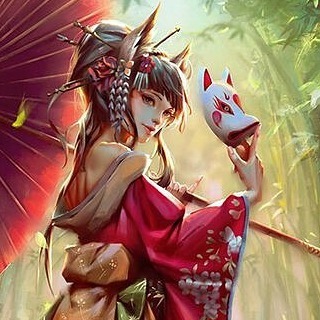
Tamamo no Mae #TamamonoMae #Tamamo #Mae #玉藻前 #Lady #Duckweed #LadyDuckweed #たまものまえ In Magadha, she was known as Lady Kayō, and became a consort of King Kalmashapada, known in Japan as Hanzoku. She used her beauty and charms to dominate the king, causing him to devour children, murder priests, and commit other unspeakable horrors. Eventually—whether because she ran out children to eat or because Kalmashapada began to turn away from her and towards Buddhism—she fled back to China. During the Zhou Dynasty she called herself Bao Si, and was known as one of the most desirable women in all of China. In 779 BCE she became a concubine of King You. Not satisfied as just a mistress, she manipulated the king into deposing his wife Queen Shen and making Bao Si his new queen. Though she was beautiful, Bao Si rarely ever smiled. In order to please his beautiful new wife, King You committed acts of such evil and atrocity that eventually all of his nobles abandoned and betrayed him. Eventually, King You was killed and Bao Si captured and the Western Zhou Dynasty was brought to an end in 771 BCE. Somehow Bao Si managed to escape again; she went into hiding for many years. Little is known of her activities until the 700s, when she resurfaced disguised as a 16-year old girl named Wakamo. She tricked the leaders of the 10th Japanese envoy to the Tang Dynasty—Kibi no Makibi, Abe no Nakamaro, and Ganjin—as they were preparing to return home to Japan. Wakamo joined their crew and took the ship to Japan, where she hid herself away for over 300 years. In the 1090s, she resurfaced once again. This time she transformed herself into a human baby and hid by the side of the road. A married couple found the baby and rescued it, taking her in as their daughter and naming her Mizukume. She proved to be an exceedingly intelligent and talented young girl, and was so beautiful that she attracted to attention of everyone around her. When she was 7 years old, Mizukume recited poetry before the emperor. His imperial majesty immediately took a liking to her and employed her as a servant in his court.
0 notes
Note
Now about the not fully human thing. Wasn't Seimei said to be descendant of sky gods and sea gods just like many other famous Japanese People? Also, He is said to be the descendant of Emperor Kogen's son Ohiko no Mikoto on his father side of the family. The Japanese Emperor is considered to be the child of heaven, which means that Seimei is considered to be a grandchild of heaven just like the man in the Takiyashahime Onmyoji Ezoshi Manga said that Taira no Masakado was a grandchild of heaven due to being a descendant of emperors.
Do you know why Abe-no-Seimei became so popular compared to any other onmyoji in folklore and literature? Is it because of who wrote his stories or something else?
There is no single clear answer. It seems safe to say there are multiple interconnected factors at play.
Seimei’s real career was genuinely extraordinary in some regards. To begin with, it was unusually long. He was around 85 years old when he passed away, and historical sources would indicate that he was still fairly active in old age (in fact, most references to him which are fully verifiable come from the second half of his life). Shin’ichi Shigeta actually argues here that Seimei's longevity in no small part contributed to cementing his legend.
However, it’s hard to argue that the times when Seimei lived were not a factor in its own right too. Institutional backing was no longer the sole reason behind the relevance of individual onmyōji. As I discussed in my recent article, by the middle of the tenth century their clientele expanded. And to find new clients, personal charisma was necessary. The shift started slightly earlier already but it doesn’t seem like the likes of Shigeoka no Kawahito or Kamo no Tadayuki left quite as much of an impression as Seimei and his contemporary Kamo no Yasunori in the long run. Legends do deal with earlier onmyōji at times, or rather reinvent earlier figures, especially Kibi no Makibi, as onmyōji, but this is often merely a way to make Seimei’s or Yasunori’s deeds appear even more amazing by making them a part of centuries old legacies (granted, standalone tales of Makibi appear for example in Konjaku Monogatari already).
Seimei’s personal influence is evident in the fact that he seemingly was responsible for popularizing formerly obscure Taizan Fukun no sai as one of the main onmyōdō rituals (check Shigeta’s article above for more specific evidence). Note that this was a performance so popular the early medieval reinterpretation of Amaterasu was in no small part driven by efforts to make her fit into rituals similar to it and Enmaten-ku. There’s also evidence that Seimei had an impact on the popularity of tsuina, a ceremony originally held only in the court but later also in private houses of nobles which served as a forerunner of modern setsubun.
The Abe clan remained influential in official onmyōdō circles long after Seimei’s death, and his heirs obviously invoked his fame to validate their own influence. There are texts only compiled after the Heian period which were attributed to him, such as Hoki Naiden. This obviously further contributed to the spread of his legend, making him relevant even as onmyōdō changed.
I don’t think it matters who wrote down the legends though, at least not before the Edo period. However, there are at least some individual elements which absolutely became such a mainstay of modern portrayals of Seimei because of the fame of specific authors who introduced and/or popularized them. A good example would be the Kuzunoha story, which was only invented in the 1600s and attained popularity because of Ryōi Asai’s Abe no Seimei Monogatari (I am not aware of any older legend claiming Seimei was not fully human, unless you want to count the Shuten Dōji variants presenting him as a manifestation of Kannon or Nagarjuna). Another thing which comes to mind as an example of influence of specific works of fiction is portraying Dōman as older than Seimei, which is a convention started by Edo period theatrical performances as far as I know. Dōman's historical counterpart was pretty obviously younger (granted, there's also no evidence he interacts with Seimei). He was still active three years after Seimei’s death, and there’s no indication he was somehow 90+ years old.
Bit of a digression but it’s worth noting Dōman isn’t Seimei’s only rival in the early stories, in Konjaku Monogatari he also faces a certain “fearsome fellow” named Chitoku who does seem to be older than him. He is an unlicensed onmyōji and comes from Harima, so it's easy to draw parallels with Dōman. However, they aren’t really similar characters; while Dōman is pretty firmly portrayed as a shady figure - a curse specialist first and foremost - Chitoku actually seems to utilize his skills to deal with pirates troubling his area. He just learns he’s a big fish in a small pond after unsuccessfully challenging Seimei. Still, I wonder if the two may have merged at some point in popular imagination.
35 notes
·
View notes
Text
Shikigami and onmyōdō through history: truth, fiction and everything in between
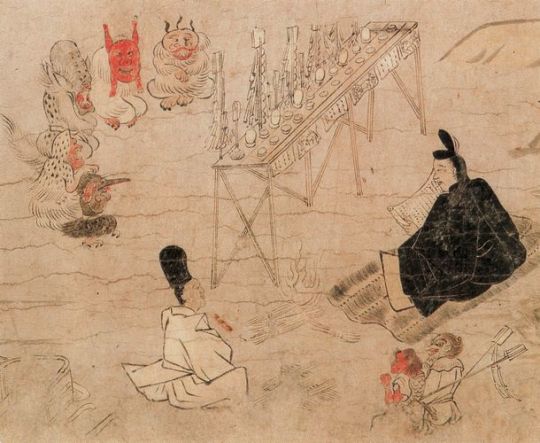
Abe no Seimei exorcising disease spirits (疫病神, yakubyōgami), as depicted in the Fudō Riyaku Engi Emaki. Two creatures who might be shikigami are visible in the bottom right corner (wikimedia commons; identification following Bernard Faure’s Rage and Ravage, pp. 57-58)
In popular culture, shikigami are basically synonymous with onmyōdō. Was this always the case, though? And what is a shikigami, anyway? These questions are surprisingly difficult to answer. I’ve been meaning to attempt to do so for a longer while, but other projects kept getting in the way. Under the cut, you will finally be able to learn all about this matter.
This isn’t just a shikigami article, though. Since historical context is a must, I also provide a brief history of onmyōdō and some of its luminaries. You will also learn if there were female onmyōji, when stars and time periods turn into deities, what onmyōdō has to do with a tale in which Zhong Kui became a king of a certain city in India - and more!
The early days of onmyōdō In order to at least attempt to explain what the term shikigami might have originally entailed, I first need to briefly summarize the history of onmyōdō (陰陽道). This term can be translated as “way of yin and yang”, and at the core it was a Japanese adaptation of the concepts of, well, yin and yang, as well as the five elements. They reached Japan through Daoist and Buddhist sources. Daoism itself never really became a distinct religion in Japan, but onmyōdō is arguably among the most widespread adaptations of its principles in Japanese context.
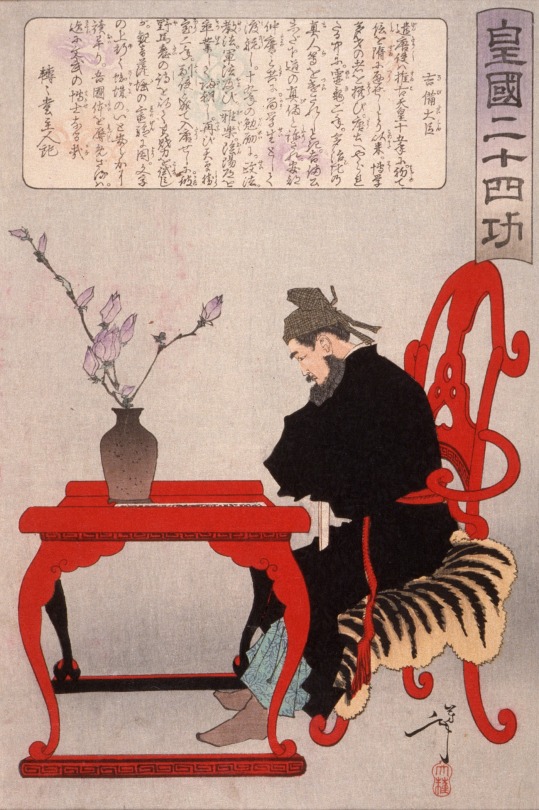
Kibi no Makibi, as depicted by Yoshitoshi Tsukioka (wikimedia commons)
It’s not possible to speak of a singular founder of onmyōdō comparable to the patriarchs of Buddhist schools. Bernard Faure notes that in legends the role is sometimes assigned to Kibi no Makibi, an eighth century official who spent around 20 years in China. While he did bring many astronomical treatises with him when he returned, this is ultimately just a legend which developed long after he passed away.
In reality onmyōdō developed gradually starting with the sixth century, when Chinese methods of divination and treatises dealing with these topics first reached Japan. Early on Buddhist monks from the Korean kingdom of Baekje were the main sources of this knowledge. We know for example that the Soga clan employed such a specialist, a certain Gwalleuk (観勒; alternatively known under the Japanese reading of his name, Kanroku).
Obviously, divination was viewed as a very serious affair, so the imperial court aimed to regulate the continental techniques in some way. This was accomplished by emperor Tenmu with the formation of the onmyōryō (陰陽寮), “bureau of yin and yang” as a part of the ritsuryō system of governance. Much like in China, the need to control divination was driven by the fears that otherwise it would be used to legitimize courtly intrigues against the emperor, rebellions and other disturbances. Officials taught and employed by onmyōryō were referred to as onmyōji (陰陽師). This term can be literally translated as “yin-yang master”. In the Nara period, they were understood essentially as a class of public servants. Their position didn’t substantially differ from that of other specialists from the onmyōryō: calendar makers, officials responsible for proper measurement of time and astrologers. The topics they dealt with evidently weren’t well known among commoners, and they were simply typical members of the literate administrative elite of their times.
Onmyōdō in the Heian period: magic, charisma and nobility
The role of onmyōji changed in the Heian period. They retained the position of official bureaucratic diviners in employ of the court, but they also acquired new duties. The distinction between them and other onmyōryō officials became blurred. Additionally their activity extended to what was collectively referred to as jujutsu (呪術), something like “magic” though this does not fully reflect the nuances of this term. They presided over rainmaking rituals, purification ceremonies, so-called “earth quelling”, and establishing complex networks of temporal and directional taboos.
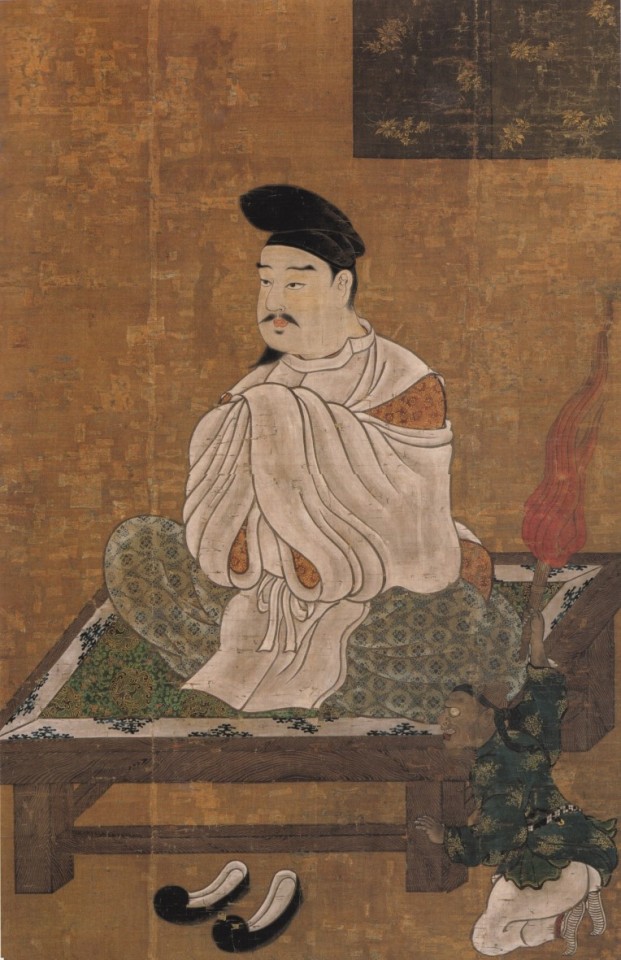
A Muromachi period depiction of Abe no Seimei (wikimedia commons)
The most famous historical onmyōji like Kamo no Yasunori and his student Abe no Seimei were active at a time when this version of onmyōdō was a fully formed - though obviously still evolving - set of practices and beliefs. In a way they represented a new approach, though - one in which personal charisma seemed to matter just as much, if not more, than official position. This change was recognized as a breakthrough by at least some of their contemporaries. For example, according to the diary of Minamoto no Tsuneyori, the Sakeiki (左經記), “in Japan, the foundations of onmyōdō were laid by Yasunori”.
The changes in part reflected the fact that onmyōji started to be privately contracted for various reasons by aristocrats, in addition to serving the state. Shin’ichi Shigeta notes that it essentially turned them from civil servants into tradespeople. However, he stresses they cannot be considered clergymen: their position was more comparable to that of physicians, and there is no indication they viewed their activities as a distinct religion. Indeed, we know of multiple Heian onmyōji, like Koremune no Fumitaka or Kamo no Ieyoshi, who by their own admission were devout Buddhists who just happened to work as professional diviners.
Shin’ichi Shigeta notes is evidence that in addition to the official, state-sanctioned onmyōji, “unlicensed” onmyōji who acted and dressed like Buddhist clergy, hōshi onmyōji (法師陰陽師) existed. The best known example is Ashiya Dōman, a mainstay of Seimei legends, but others are mentioned in diaries, including the famous Pillow Book. It seems nobles particularly commonly employed them to curse rivals. This was a sphere official onmyōji abstained from due to legal regulations. Curses were effectively considered crimes, and government officials only performed apotropaic rituals meant to protect from them. The Heian period version of onmyōdō captivated the imagination of writers and artists, and its slightly exaggerated version present in classic literature like Konjaku Monogatari is essentially what modern portrayals in fiction tend to go back to.
Medieval onmyōdō: from abstract concepts to deities
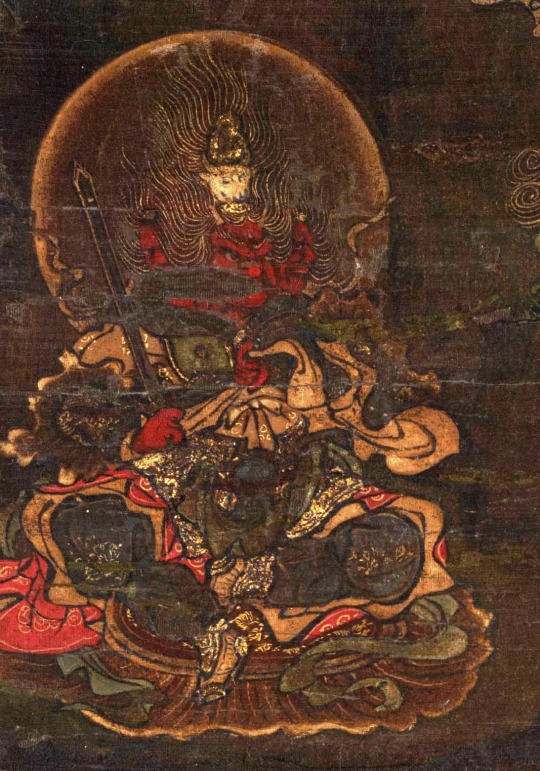
Gozu Tennō (wikimedia commons)
Further important developments occurred between the twelfth and fourteenth centuries. This period was the beginning of the Japanese “middle ages” which lasted all the way up to the establishment of the Tokugawa shogunate. The focus in onmyōdō in part shifted towards new, or at least reinvented, deities, such as calendarical spirits like Daishōgun (大将軍) and Ten’ichijin (天一神), personifications of astral bodies and concepts already crucial in earlier ceremonies. There was also an increased interest in Chinese cosmological figures like Pangu, reimagined in Japan as “king Banko”. However, the most famous example is arguably Gozu Tennō, who you might remember from my Susanoo article.
The changes in medieval onmyōdō can be described as a process of convergence with esoteric Buddhism. The points of connection were rituals focused on astral and underworld deities, such as Taizan Fukun or Shimei (Chinese Siming). Parallels can be drawn between this phenomenon and the intersection between esoteric Buddhism and some Daoist schools in Tang China. Early signs of the development of a direct connection between onmyōdō and Buddhism can already be found in sources from the Heian period, for example Kamo no Yasunori remarked that he and other onmyōji depend on the same sources to gain proper understanding of ceremonies focused on the Big Dipper as Shingon monks do.
Much of the information pertaining to the medieval form of onmyōdō is preserved in Hoki Naiden (ほき内伝; “Inner Tradition of the Square and the Round Offering Vessels”), a text which is part divination manual and part a collection of myths. According to tradition it was compiled by Abe no Seimei, though researchers generally date it to the fourteenth century. For what it’s worth, it does seem likely its author was a descendant of Seimei, though. Outside of specialized scholarship Hoki Naiden is fairly obscure today, but it’s worth noting that it was a major part of the popular perception of onmyōdō in the Edo period. A novel whose influence is still visible in the modern image of Seimei, Abe no Seimei Monogatari (安部晴明物語), essentially revolves around it, for instance.
Onmyōdō in the Edo period: occupational licensing
Novels aside, the first post-medieval major turning point for the history of onmyōdō was the recognition of the Tsuchimikado family as its official overseers in 1683. They were by no means new to the scene - onmyōji from this family already served the Ashikaga shoguns over 250 years earlier. On top of that, they were descendants of the earlier Abe family, the onmyōji par excellence. The change was not quite the Tsuchimikado’s rise, but rather the fact the government entrusted them with essentially regulating occupational licensing for all onmyōji, even those who in earlier periods existed outside of official administration.
As a result of the new policies, various freelance practitioners could, at least in theory, obtain a permit to perform the duties of an onmyōji. However, as the influence of the Tsuchimikado expanded, they also sought to oblige various specialists who would not be considered onmyōji otherwise to purchase licenses from them. Their aim was to essentially bring all forms of divination under their control. This extended to clergy like Buddhist monks, shugenja and shrine priests on one hand, and to various performers like members of kagura troupes on the other.
Makoto Hayashi points out that while throughout history onmyōji has conventionally been considered a male occupation, it was possible for women to obtain licenses from the Tsuchimikado. Furthermore, there was no distinct term for female onmyōji, in contrast with how female counterparts of Buddhist monks, shrine priests and shugenja were referred to with different terms and had distinct roles defined by their gender. As far as I know there’s no earlier evidence for female onmyōji, though, so it’s safe to say their emergence had a lot to do with the specifics of the new system. It seems the poems of the daughter of Kamo no Yasunori (her own name is unknown) indicate she was familiar with yin-yang theory or at least more broadly with Chinese philosophy, but that’s a topic for a separate article (stay tuned), and it's not quite the same, obviously.
The Tsuchimikado didn’t aim to create a specific ideology or systems of beliefs. Therefore, individual onmyōji - or, to be more accurate, individual people with onmyōji licenses - in theory could pursue new ideas. This in some cases lead to controversies: for instance, some of the people involved in the (in)famous 1827 Osaka trial of alleged Christians (whether this label really is applicable is a matter of heated debate) were officially licensed onmyōji. Some of them did indeed possess translated books written by Portuguese missionaries, which obviously reflected Catholic outlook. However, Bernard Faure suggests that some of the Edo period onmyōji might have pursued Portuguese sources not strictly because of an interest in Catholicism but simply to obtain another source of astronomical knowledge.
The legacy of onmyōdō
In the Meiji period, onmyōdō was banned alongside shugendō. While the latter tradition experienced a revival in the second half of the twentieth century, the former for the most part didn’t. However, that doesn’t mean the history of onmyōdō ends once and for all in the second half of the nineteenth century.
Even today in some parts of Japan there are local religious traditions which, while not identical with historical onmyōdō, retain a considerable degree of influence from it. An example often cited in scholarship is Izanagi-ryū (いざなぎ流) from the rural Monobe area in the Kōchi Prefecture. Mitsuki Ueno stresses that the occasional references to Izanagi-ryū as “modern onmyōdō” in literature from the 1990s and early 2000s are inaccurate, though. He points out they downplay the unique character of this tradition, and that it shows a variety of influences. Similar arguments have also been made regarding local traditions from the Chūgoku region.
Until relatively recently, in scholarship onmyōdō was basically ignored as superstition unworthy of serious inquiries. This changed in the final decades of the twentieth century, with growing focus on the Japanese middle ages among researchers. The first monographs on onmyōdō were published in the 1980s. While it’s not equally popular as a subject of research as esoteric Buddhism and shugendō, formerly neglected for similar reasons, it has nonetheless managed to become a mainstay of inquiries pertaining to the history of religion in Japan.
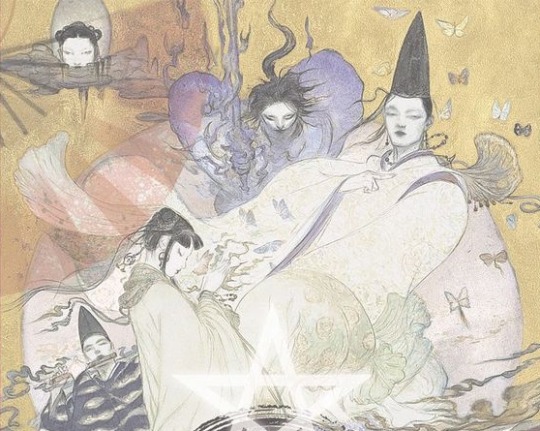
Yoshitaka Amano's illustration of Baku Yumemakura's fictionalized portrayal of Abe no Seimei (right) and other characters from his novels (reproduced here for educational purposes only)
Of course, it’s also impossible to talk about onmyōdō without mentioning the modern “onmyōdō boom”. Starting with the 1980s, onmyōdō once again became a relatively popular topic among writers. Novel series such as Baku Yumemakura’s Onmyōji, Hiroshi Aramata’s Teito Monogatari or Natsuhiko Kyōgoku’s Kyōgōkudō and their adaptations in other media once again popularized it among general audiences. Of course, since these are fantasy or mystery novels, their historical accuracy tends to vary (Yumemakura in particular is reasonably faithful to historical literature, though). Still, they have a lasting impact which would be impossible to accomplish with scholarship alone.
Shikigami: historical truth, historical fiction, or both?
You might have noticed that despite promising a history of shikigami, I haven’t used this term even once through the entire crash course in history of onmyōdō. This was a conscious choice. Shikigami do not appear in any onmyōdō texts, even though they are a mainstay of texts about onmyōdō, and especially of modern literature involving onmyōji.
It would be unfair to say shikigami and their prominence are merely a modern misconception, though. Virtually all of the famous legends about onmyōji feature shikigami, starting with the earliest examples from the eleventh century. Based on Konjaku Monogatari, there evidently was a fascination with shikigami at the time of its compilation. Fujiwara no Akihira in the Shinsarugakuki treats the control of shikigami as an essential skill of an onmyōji, alongside the abilities to “freely summon the twelve guardian deities, call thirty-six types of wild birds (...), create spells and talismans, open and close the eyes of kijin (鬼神; “demon gods”), and manipulate human souls”.
It is generally agreed that such accounts, even though they belong to the realm of literary fiction, can shed light on the nature and importance of shikigami. They ultimately reflect their historical context to some degree. Furthermore, it is not impossible that popular understanding of shikigami based on literary texts influenced genuine onmyōdō tradition. It’s worth pointing out that today legends about Abe no Seimei involving them are disseminated by two contemporary shrines dedicated to him, the Seimei Shrine (晴明神社) in Kyoto and the Abe no Seimei Shrine (安倍晴明神社) in Osaka. Interconnected networks of exchange between literature and religious practice are hardly a unique or modern phenomenon.
However, even with possible evidence from historical literature taken into account, it is not easy to define shikigami. The word itself can be written in three different ways: 式神 (or just 式), 識神 and 職神, with the first being the default option. The descriptions are even more varied, which understandably lead to the rise of numerous interpretations in modern scholarship. Carolyn Pang in her recent treatments of shikigami, which you can find in the bibliography, has recently divided them into five categories. I will follow her classification below.
Shikigami take 1: rikujin-shikisen
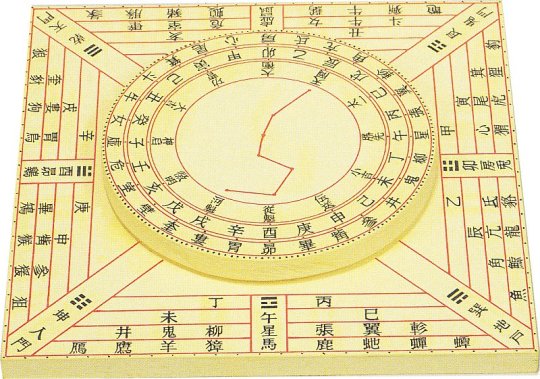
An example of shikiban, the divination board used in rikujin-shikisen (Museum of Kyoto, via onmarkproductions.com; reproduced here for educational purposes only)
A common view is that shikigami originate as a symbolic representation of the power of shikisen (式占) or more specifically rikujin-shikisen (六壬式占), the most common form of divination in onmyōdō. It developed from Chinese divination methods in the Nara period, and remained in the vogue all the way up to the sixteenth century, when it was replaced by ekisen (易占), a method derived from the Chinese Book of Changes.
Shikisen required a special divination board known as shikiban (式盤), which consists of a square base, the “earth panel” (地盤, jiban), and a rotating circle placed on top of it, the “heaven panel” (天盤, tenban). The former was marked with twelve points representing the signs of the zodiac and the latter with representations of the “twelve guardians of the months” (十二月将, jūni-gatsushō; their identity is not well defined). The heaven panel had to be rotated, and the diviner had to interpret what the resulting combination of symbols represents. Most commonly, it was treated as an indication whether an unusual phenomenon (怪/恠, ke) had positive or negative implications. It’s worth pointing out that in the middle ages the shikiban also came to be used in some esoteric Buddhist rituals, chiefly these focused on Dakiniten, Shōten and Nyoirin Kannon. However, they were only performed between the late Heian and Muromachi periods, and relatively little is known about them. In most cases the divination board was most likely modified to reference the appropriate esoteric deities.
Shikigami take 2: cognitive abilities
While the view that shikigami represented shikisen is strengthened by the fact both terms share the kanji 式, a variant writing, 識神, lead to the development of another proposal. Since the basic meaning of 識 is “consciousness”, it is sometimes argued that shikigami were originally an “anthropomorphic realization of the active psychological or mental state”, as Caroline Pang put it - essentially, a representation of the will of an onmyōji. Most of the potential evidence in this case comes from Buddhist texts, such as Bosatsushotaikyō (菩薩処胎経).
However, Bernard Faure assumes that the writing 識神 was a secondary reinterpretation, basically a wordplay based on homonymy. He points out the Buddhist sources treat this writing of shikigami as a synonym of kushōjin (倶生神). This term can be literally translated as “deities born at the same time”. Most commonly it designates a pair of minor deities who, as their name indicates, come into existence when a person is born, and then records their deeds through their entire life. Once the time for Enma’s judgment after death comes, they present him with their compiled records. It has been argued that they essentially function like a personification of conscience.
Shikigami take 3: energy
A further speculative interpretation of shikigami in scholarship is that this term was understood as a type of energy present in objects or living beings which onmyōji were believed to be capable of drawing out and harnessing to their ends. This could be an adaptation of the Daoist notion of qi (氣). If this definition is correct, pieces of paper or wooden instruments used in purification ceremonies might be examples of objects utilized to channel shikigami.
The interpretation of shikigami as a form of energy is possibly reflected in Konjaku Monogatari in the tale The Tutelage of Abe no Seimei under Tadayuki. It revolves around Abe no Seimei’s visit to the house of the Buddhist monk Kuwanten from Hirosawa. Another of his guests asks Seimei if he is capable of killing a person with his powers, and if he possesses shikigami. He affirms that this is possible, but makes it clear that it is not an easy task. Since the guests keep urging him to demonstrate nonetheless, he promptly demonstrates it using a blade of grass. Once it falls on a frog, the animal is instantly crushed to death. From the same tale we learn that Seimei’s control over shikigami also let him remotely close the doors and shutters in his house while nobody was inside.
Shikigami take 4: curse As I already mentioned, arts which can be broadly described as magic - like the already mentioned jujutsu or juhō (呪法, “magic rituals”) - were regarded as a core part of onmyōji’s repertoire from the Heian period onward. On top of that, the unlicensed onmyōji were almost exclusively associated with curses. Therefore, it probably won’t surprise you to learn that yet another theory suggests shikigami is simply a term for spells, curses or both. A possible example can be found in Konjaku Monogatari, in the tale Seimei sealing the young Archivist Minor Captains curse - the eponymous curse, which Seimei overcomes with protective rituals, is described as a shikigami.

Kunisuda Utagawa's illustration of an actor portraying Dōman in a kabuki play (wikimedia commons)
Similarities between certain descriptions of shikigami and practices such as fuko (巫蠱) and goraihō (五雷法) have been pointed out. Both of these originate in China. Fuko is the use of poisonous, venomous or otherwise negatively perceived animals to create curses, typically by putting them in jars, while goraihō is the Japanese version of Daoist spells meant to control supernatural beings, typically ghosts or foxes. It’s worth noting that a legend according to which Dōman cursed Fujiwara no Michinaga on behalf of lord Horikawa (Fujiwara no Akimitsu) involves him placing the curse - which is itself not described in detail - inside a jar.
Mitsuki Ueno notes that in the Kōchi Prefecture the phrase shiki wo utsu, “to strike with a shiki”, is still used to refer to cursing someone. However, shiki does not necessarily refer to shikigami in this context, but rather to a related but distinct concept - more on that later.
Shikigami take 5: supernatural being
While all four definitions I went through have their proponents, yet another option is by far the most common - the notion of shikigami being supernatural beings controlled by an onmyōji. This is essentially the standard understanding of the term today among general audiences. Sometimes attempts are made to identify it with a specific category of supernatural beings, like spirits (精霊, seirei), kijin or lesser deities (下級神, kakyū shin). However, none of these gained universal support. Generally speaking, there is no strong indication that shikigami were necessarily imagined as individualized beings with distinct traits.
The notion of shikigami being supernatural beings is not just a modern interpretation, though, for the sake of clarity. An early example where the term is unambiguously used this way is a tale from Ōkagami in which Seimei sends a nondescript shikigami to gather information. The entity, who is not described in detail, possesses supernatural skills, but simultaneously still needs to open doors and physically travel.
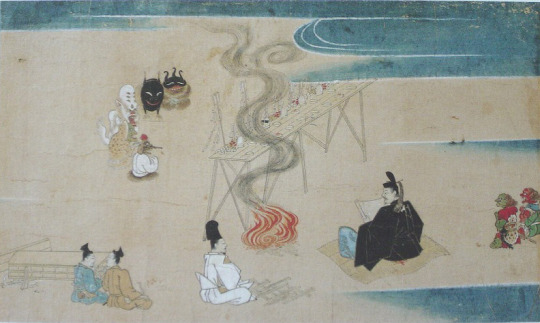
An illustration from Nakifudō Engi Emaki (wikimedia commons)
In Genpei Jōsuiki there is a reference to Seimei’s shikigami having a terrifying appearance which unnerved his wife so much he had to order the entities to hide under a bride instead of residing in his house. Carolyn Pang suggests that this reflects the demon-like depictions from works such as Abe no Seimei-kō Gazō (安倍晴明公画像; you can see it in the Heian section), Fudōriyaku Engi Emaki and Nakifudō Engi Emaki.
Shikigami and related concepts

A gohō dōji, as depicted in the Shigisan Engi Emaki (wikimedia commons)
The understanding of shikigami as a “spirit servant” of sorts can be compared with the Buddhist concept of minor protective deities, gohō dōji (護法童子; literally “dharma-protecting lads”). These in turn were just one example of the broad category of gohō (護法), which could be applied to virtually any deity with protective qualities, like the historical Buddha’s defender Vajrapāṇi or the Four Heavenly Kings. A notable difference between shikigami and gohō is the fact that the former generally required active summoning - through chanting spells and using mudras - while the latter manifested on their own in order to protect the pious. Granted, there are exceptions. There is a well attested legend according to which Abe no Seimei’s shikigami continued to protect his residence on own accord even after he passed away. Shikigami acting on their own are also mentioned in Zoku Kojidan (続古事談). It attributes the political downfall of Minamoto no Takaakira (源高明; 914–98) to his encounter with two shikigami who were left behind after the onmyōji who originally summoned them forgot about them.
A degree of overlap between various classes of supernatural helpers is evident in texts which refer to specific Buddhist figures as shikigami. I already brought up the case of the kushōjin earlier. Another good example is the Tendai monk Kōshū’s (光宗; 1276–1350) description of Oto Gohō (乙護法). He is “a shikigami that follows us like the shadow follows the body. Day or night, he never withdraws; he is the shikigami that protects us” (translation by Bernard Faure). This description is essentially a reversal of the relatively common title “demon who constantly follow beings” (常随魔, jōzuima). It was applied to figures such as Kōjin, Shōten or Matarajin, who were constantly waiting for a chance to obstruct rebirth in a pure land if not placated properly.
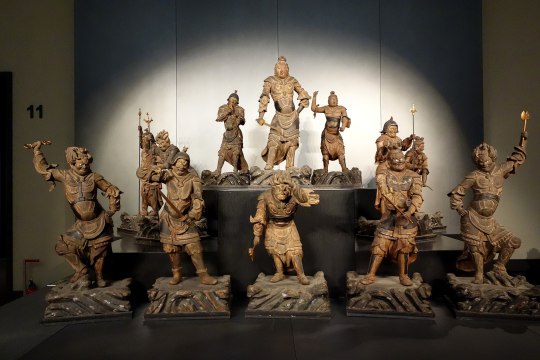
The Twelve Heavenly Generals (Tokyo National Museum, via wikimedia commons)
A well attested group of gohō, the Twelve Heavenly Generals (十二神将, jūni shinshō), and especially their leader Konpira (who you might remember from my previous article), could be labeled as shikigami. However, Fujiwara no Akihira’s description of onmyōji skills evidently presents them as two distinct classes of beings.
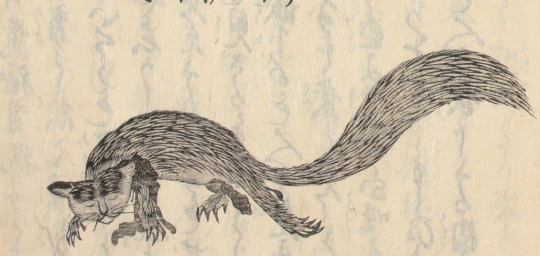
A kuda-gitsune, as depicted in Shōzan Chomon Kishū by Miyoshi Shōzan (Waseda University History Museum; reproduced here for educational purposes only)
Granted, Akihira also makes it clear that controlling shikigami and animals are two separate skills. Meanwhile, there is evidence that in some cases animal familiars, especially kuda-gitsune used by iizuna (a term referring to shugenja associated with the cult of, nomen omen, Iizuna Gongen, though more broadly also something along the lines of “sorcerer”), were perceived as shikigami.
Beliefs pertaining to gohō dōji and shikigami seemingly merged in Izanagi-ryū, which lead to the rise of the notion of shikiōji (式王子; ōji, literally “prince”, can be another term for gohō dōji). This term refers to supernatural beings summoned by a ritual specialist (祈祷師, kitōshi) using a special formula from doctrinal texts (法文, hōmon). They can fulfill various functions, though most commonly they are invoked to protect a person, to remove supernatural sources of diseases, to counter the influence of another shikiōji or in relation to curses.
Tenkeisei, the god of shikigami

Tenkeisei (wikimedia commons)
The final matter which warrants some discussion is the unusual tradition regarding the origin of shikigami which revolves around a deity associated with this concept.
In the middle ages, a belief that there were exactly eighty four thousand shikigami developed. Their source was the god Tenkeisei (天刑星; also known as Tengyōshō). His name is the Japanese reading of Chinese Tianxingxing. It can be translated as “star of heavenly punishment”. This name fairly accurately explains his character. He was regarded as one of the so-called “baleful stars” (凶星, xiong xing) capable of controlling destiny. The “punishment” his name refers to is his treatment of disease demons (疫鬼, ekiki). However, he could punish humans too if not worshiped properly.
Today Tenkeisei is best known as one of the deities depicted in a series of paintings known as Extermination of Evil, dated to the end of the twelfth century. He has the appearance of a fairly standard multi-armed Buddhist deity. The anonymous painter added a darkly humorous touch by depicting him right as he dips one of the defeated demons in vinegar before eating him. Curiously, his adversaries are said to be Gozu Tennō and his retinue in the accompanying text. This, as you will quickly learn, is a rather unusual portrayal of the relationship between these two deities.
I’m actually not aware of any other depictions of Tenkeisei than the painting you can see above. Katja Triplett notes that onmyōdō rituals associated with him were likely surrounded by an aura of secrecy, and as a result most depictions of him were likely lost or destroyed. At the same time, it seems Tenkeisei enjoyed considerable popularity through the Kamakura period. This is not actually paradoxical when you take the historical context into account: as I outlined in my recent Amaterasu article, certain categories of knowledge were labeled as secret not to make their dissemination forbidden, but to imbue them with more meaning and value.
Numerous talismans inscribed with Tenkeisei’s name are known. Furthermore, manuals of rituals focused on him have been discovered. The best known of them, Tenkeisei-hō (天刑星法; “Tenkeisei rituals”), focuses on an abisha (阿尾捨, from Sanskrit āveśa), a ritual involving possession by the invoked deity. According to a legend was transmitted by Kibi no Makibi and Kamo no Yasunori. The historicity of this claim is doubtful, though: the legend has Kamo no Yasunori visit China, which he never did. Most likely mentioning him and Makibi was just a way to provide the text with additional legitimacy.
Other examples of similar Tenkeisei manuals include Tenkeisei Gyōhō (天刑星行法; “Methods of Tenkeisei Practice”) and Tenkeisei Gyōhō Shidai (天刑星行法次第; “Methods of Procedure for the Tenkeisei Practice”). Copies of these texts have been preserved in the Shingon temple Kōzan-ji.
The Hoki Naiden also mentions Tenkeisei. It equates him with Gozu Tennō, and explains both of these names refer to the same deity, Shōki (商貴), respectively in heaven and on earth. While Shōki is an adaptation of the famous Zhong Kui, it needs to be pointed out that here he is described not as a Tang period physician but as an ancient king of Rajgir in India. Furthermore, he is a yaksha, not a human. This fairly unique reinterpretation is also known from the historical treatise Genkō Shakusho. Post scriptum The goal of this article was never to define shikigami. In the light of modern scholarship, it’s basically impossible to provide a single definition in the first place. My aim was different: to illustrate that context is vital when it comes to understanding obscure historical terms. Through history, shikigami evidently meant slightly different things to different people, as reflected in literature. However, this meaning was nonetheless consistently rooted in the evolving perception of onmyōdō - and its internal changes. In other words, it reflected a world which was fundamentally alive. The popular image of Japanese culture and religion is often that of an artificial, unchanging landscape straight from the “age of the gods”, largely invented in the nineteenth century or later to further less than noble goals. The case of shikigami proves it doesn’t need to be, though. The malleable, ever-changing image of shikigami, which remained a subject of popular speculation for centuries before reemerging in a similar role in modern times, proves that the more complex reality isn’t necessarily any less interesting to new audiences.
Bibliography
Bernard Faure, A Religion in Search of a Founder?
Idem, Rage and Ravage (Gods of Medieval Japan vol. 3)
Makoto Hayashi, The Female Christian Yin-Yang Master
Jun’ichi Koike, Onmyōdō and Folkloric Culture: Three Perspectives for the Development of Research
Irene H. Lin, Child Guardian Spirits (Gohō Dōji) in the Medieval Japanese Imaginaire
Yoshifumi Nishioka, Aspects of Shikiban-Based Mikkyō Rituals
Herman Ooms, Yin-Yang's Changing Clientele, 600-800 (note there is n apparent mistake in one of the footnotes, I'm pretty sure the author wanted to write Mesopotamian astronomy originated 4000 years ago, not 4 millenia BCE as he did; the latter date makes little sense)
Carolyn Pang, Spirit Servant: Narratives of Shikigami and Onmyōdō Developments
Idem, Uncovering Shikigami. The Search for the Spirit Servant of Onmyōdō
Shin’ichi Shigeta, Onmyōdō and the Aristocratic Culture of Everyday Life in Heian Japan
Idem, A Portrait of Abe no Seimei
Katja Triplett, Putting a Face on the Pathogen and Its Nemesis. Images of Tenkeisei and Gozutennō, Epidemic-Related Demons and Gods in Medieval Japan
Mitsuki Umeno, The Origins of the Izanagi-ryū Ritual Techniques: On the Basis of the Izanagi saimon
Katsuaki Yamashita, The Characteristics of On'yōdō and Related Texts
192 notes
·
View notes
Note
Are there any other surviving Onmyōji clans other than Tsuchimikado and Kadenokōji? And which one of the other famous Onmyōji other than Abe and Kamo?
There aren’t all that many famous onmyōji who wouldn’t be Abe or Kamo or their descendants. Kibi no Makibi despite being portrayed as an onmyōji in fiction as early as in the late Heian period actually had nothing to do with onmyōdō in reality, Chitoku, Hōdō Shonin and Kiichi Hōgen are fictional characters, Dōman is likely based on a real person but one who we know next to nothing about. The non-Kamo non-Abe Heian period historical onmyōji, like Koremune no Fumitaka, Shigeoka no Kawahito or Yuge no Koreo didn’t really attain much fame as legendary characters (though this does not mean legends about them don’t exist, or that they were not historically notable), and they didn’t come from families specifically associated with onmyōdō.
The Kamo and the Abe were essentially the only clans to hold major hereditary positions in the onmyōdō bureau in the long run and the Kadenokōji, Kōtokui and Tsuchimikado who shared a similar distinction later descend directly from them. The Tsuchimikado family still exists. They are involved in the Tensha Tsuchimikado Shinto. However, while it contains some elements of onmyōdō, it was originally formed essentially as a typical mid-Edo example of practical application of the ideas of intellectual movements focused on constructing a new version of Shinto. The Kadenokōji effectively ceased to exist by the end of the sixteenth century. Their Kamo forerunners were already losing ground as early as during the reign of Go-Shirakawa, who favored the Abe clan; so did the Ashikaga shoguns. There’s an unrelated family sharing the Kadenokōji name which instead descends from the Karasumaru, a branch of the Fujiwara; pretty sure the modern bearers of the name are more likely to be their descendants.
The Kōtokui, who are sort of complicated (they descended from an Abe side branch whose head was adopted by Kamo) were still around in the early Edo period. They resided in Nara. They feuded with the Tsuchimikado through the mid to late 1600s but eventually their position declined and if Japanese wikipedia is to be believed their further history is effectively unknown.
In the Edo period the number of onmyōji grew considerably but it’s hard to really speak of new “onmyōdō clans” other because aside from the Tsuchimikado clan keeping their hereditary posts, onmyōdō became a matter of paying for a permit. The new regulations outright prohibited the inheritance of the status of onmyōji. A child of a non-Tsuchimikado onmyōji could only follow in their parent’s footsteps if they purchased their own license. Tsuchimikado extended their influence by asserting that other types of diviners, religious personnel and even entertainers should operate based on the same permits as onmyōji.
7 notes
·
View notes
Note
Are there any other samurai clans other than Minamoto or Fujiwara that are involved in supernatural stuff? I know there are the likes of Taira no Koremochi or Sakanoue Tamuramaro, but it seems those two are the only ones outside Minamoto and Fujiwara that encountered Oni-like beings.
Regardless of the military exploits of Fujiwara no Hidesato and the like, Fujiwara were a court noble (kuge) clan first and foremost and their power declined with the rise of military governments, so I would not count them as a "samurai clan" tbh. If you're counting them you also have to count Kibi no Makibi (encounters an oni in Kibi Daijin Nitto Emaki), Miyako no Yoshika (encounters an oni in multiple sources), Ki no Haseo (encounters an oni in Haseo zoshi), Ono no Takamura (encounters oni in hell), or virtually any story involving an onmyoji considering both Abe and Kamo clans were court nobility. It is natural stories either originally devised in the Heian period or dealing with the Heian period feature the major political players of this era - this is essentially the phenomenon you are somewhat inaccurately describing. Heian period remained the favored backdrop for many sorts of stories, and arguably retains this role today, hence you will see considerably more Minamotos or Kamos than Tokugawas or Tsuchimikados in such contexts. This being said, there is no shortage of stories set in later periods in which historical figures - samurai or not - encounter supernatural beings, also. Yaegaki-hime comes to mind as an example. You just need to look beyond the sources you're depending on atm. However, you have to also take into account that by the Edo period many people were reasonably well educated and simply didn't believe in supernatural creatures; or at the very least did not see them as something people would encounter in these times, at least not in urban areas. Wondering why you don't hear about the Tokugawa shoguns encountering oni is kind of like wondering why you don't hear about Louis XIV encountering centaurs. It was an era of growing literacy rates, playful engagement with the classics, but also strenghtened confucian euhemerism. As Noriko Reider put it, oni were essentially de-demonized and became a commodity - and older stories were being reinvented as satire. Her book is open access, you can read it here. I guarantee you will understand the matters you've asked about much better after reading it.
14 notes
·
View notes
Photo

[Update] 映画「桃源郷ラビリンス」(eiga tougenkyou labyrinth)
roadshow: November 2019
Cast:
Torigoe Yuuki as Kibi Momotarou (吉備桃太郎) Takahashi Kensuke as Yamamoto Takeru (大和尊) Sugie Taishi as Inukai Tsuyoshi (犬養津与志) Asuma Kousuke as Sasamori Rui (楽々森類) Yamamoto Ikkei as Tamaomi Juri (珠臣樹里) Nagae Ryouki as Sakata Ginga (坂田銀牙) Kento as Urashima Ukai (浦島雨海) Kawakami Shouta as Shutendouji (酒呑童子) Imade Mai as Ibarakidouji (茨木童子) Shiotsuki Shuu as Watanabe no Tsuna (渡辺綱) Ujiie Ren as Minamoto no Monjumaru (源文殊丸) Miyamoto Hidemitsu as Urabe no Suetake (卜部季武) Kurihara Taiga as Tachibana Sadamitsu (橘貞光) Nakamura Yuuichi as Kibi Makibi (吉備真備) Nakada Hiroki as Martin Baird (マーティン・ベアード) Kaneko Noboru as Abraham D Stoker (エイブラハム・D・ストーカー)
homepage twitter natalie
#桃源郷ラビリンス#tougenkyou labyrinth#鳥越裕貴#torigoe yuuki#高橋健介#takahashi kensuke#杉江大志#sugie taishi#遊馬晃祐#asuma kousuke#山本一慶#yamamoto ikkei#長江崚行#nagae ryouki#健人#kento#川上将大#kawakami shouta#今出舞#imade mai#汐月しゅう#shiotsuki shuu#氏家蓮#ujiie ren#宮元英光#miyamoto hidemitsu#栗原大河#kurihara taiga#中村優一#nakamura yuuichi
11 notes
·
View notes
Note
Do you know why Abe-no-Seimei became so popular compared to any other onmyoji in folklore and literature? Is it because of who wrote his stories or something else?
There is no single clear answer. It seems safe to say there are multiple interconnected factors at play.
Seimei’s real career was genuinely extraordinary in some regards. To begin with, it was unusually long. He was around 85 years old when he passed away, and historical sources would indicate that he was still fairly active in old age (in fact, most references to him which are fully verifiable come from the second half of his life). Shin’ichi Shigeta actually argues here that Seimei's longevity in no small part contributed to cementing his legend.
However, it’s hard to argue that the times when Seimei lived were not a factor in its own right too. Institutional backing was no longer the sole reason behind the relevance of individual onmyōji. As I discussed in my recent article, by the middle of the tenth century their clientele expanded. And to find new clients, personal charisma was necessary. The shift started slightly earlier already but it doesn’t seem like the likes of Shigeoka no Kawahito or Kamo no Tadayuki left quite as much of an impression as Seimei and his contemporary Kamo no Yasunori in the long run. Legends do deal with earlier onmyōji at times, or rather reinvent earlier figures, especially Kibi no Makibi, as onmyōji, but this is often merely a way to make Seimei’s or Yasunori’s deeds appear even more amazing by making them a part of centuries old legacies (granted, standalone tales of Makibi appear for example in Konjaku Monogatari already).
Seimei’s personal influence is evident in the fact that he seemingly was responsible for popularizing formerly obscure Taizan Fukun no sai as one of the main onmyōdō rituals (check Shigeta’s article above for more specific evidence). Note that this was a performance so popular the early medieval reinterpretation of Amaterasu was in no small part driven by efforts to make her fit into rituals similar to it and Enmaten-ku. There’s also evidence that Seimei had an impact on the popularity of tsuina, a ceremony originally held only in the court but later also in private houses of nobles which served as a forerunner of modern setsubun.
The Abe clan remained influential in official onmyōdō circles long after Seimei’s death, and his heirs obviously invoked his fame to validate their own influence. There are texts only compiled after the Heian period which were attributed to him, such as Hoki Naiden. This obviously further contributed to the spread of his legend, making him relevant even as onmyōdō changed.
I don’t think it matters who wrote down the legends though, at least not before the Edo period. However, there are at least some individual elements which absolutely became such a mainstay of modern portrayals of Seimei because of the fame of specific authors who introduced and/or popularized them. A good example would be the Kuzunoha story, which was only invented in the 1600s and attained popularity because of Ryōi Asai’s Abe no Seimei Monogatari (I am not aware of any older legend claiming Seimei was not fully human, unless you want to count the Shuten Dōji variants presenting him as a manifestation of Kannon or Nagarjuna). Another thing which comes to mind as an example of influence of specific works of fiction is portraying Dōman as older than Seimei, which is a convention started by Edo period theatrical performances as far as I know. Dōman's historical counterpart was pretty obviously younger (granted, there's also no evidence he interacts with Seimei). He was still active three years after Seimei’s death, and there’s no indication he was somehow 90+ years old.
Bit of a digression but it’s worth noting Dōman isn’t Seimei’s only rival in the early stories, in Konjaku Monogatari he also faces a certain “fearsome fellow” named Chitoku who does seem to be older than him. He is an unlicensed onmyōji and comes from Harima, so it's easy to draw parallels with Dōman. However, they aren’t really similar characters; while Dōman is pretty firmly portrayed as a shady figure - a curse specialist first and foremost - Chitoku actually seems to utilize his skills to deal with pirates troubling his area. He just learns he’s a big fish in a small pond after unsuccessfully challenging Seimei. Still, I wonder if the two may have merged at some point in popular imagination.
35 notes
·
View notes